|
A | B | C | D | E | F | G | H | I | J | K | L | M | N | O | P | Q | R | S | T | U | V | W | X | Y | Z |
A |
ABRAHAM DARBY – DAVID AUSTIN ROSE
The loveliest attribute once you have enjoyed the surprise of the various colours in each flower, is of course, the magnificent fragrance … strong and fruity and always there! The blowsy petals just urge you to take a sniff and you will never, ever be disappointed by the perfume of. Abraham Darby can be used as a climbing rose and is wonderful espaliered to a screen wall or fence – if planting as a free-standing shrub, three roses should be planted .75cms apart and they will gracefully support each other and hold the flowers up. Because the flowers are so large and filled with petals, this flower is not really suited to the open vase. However, when floated in a bowl, Abraham Darby roses will last many days and then literally, just fall apart. The petals when dried would make a magnificent addition to a pot-pourri and provided you don’t spray chemicals on your roses, one flower from this rose would give a lovely handful of petals to add to your recipe!
CULTURAL NOTES:The generally sunny, dry and hot conditions of the Australian garden are particularly well suited to planting roses and roses flourish in our gardens when you take measures to provide the following: WATER – Roses are very deep rooted plants and require one good, deep soaking at least every 10 days in hot and dry conditions. FEED – Because roses flower throughout all but the Winter season, they should be regularly fertilized with quality (preferably organic) fertilizer which contains a balance of major nutrients (NPK) and trace elements. The fertilizer should be applied at least once a month – small amount often – with fortnightly applications of liquid seaweed over the foliage. PRUNE – During Winter, 70% of the rose plant should be pruned and all old wood removed back to the crown and the bush pruned to shape. MULCH – Particular attention to application of lucerne or pea straw directly around the root-zone of each rose will enhance the overall health of the rose and then the whole bed should be mulched to 75mm with any other mulch medium available. |
ALTISSIMO – MODERN CLIMBING ROSE, REPEAT FLOWERING, LARGE, BRILLIANT BRIGHT BLOOD-RED SINGLE-PETALLED
The large, open flowers with 7-8 petals, display yellow stamens which attract the bees for pollination. Altissimo is lightly fragrant and will repeat flower well throughout the Spring, Summer and Autumn if trimmed constantly as the blooms finish. Altissimo is a very easy-care rose with dark leathery, exceptionally healthy foliage and in Italian, Altissimo means ‘in the highest’ – Altissimo is very appropriately named because it is a very worth climbing rose to place at the top of your list of ‘must have’ roses since it has so many wonderful qualities and is well suited to a variety of situations in the rose garden. Altissimo happily lets you be the boss and make it do whatever it is you want and whichever site you would like it to cover, this intensely bright coloured, free-flowering climbing rose will never disappoint!
CULTURAL NOTES:The generally sunny, dry and hot conditions of the Australian garden are particularly well suited to planting roses and roses flourish in our gardens when you take measures to provide the following: WATER – Roses are very deep rooted plants and require one good, deep soaking at least every 10 days in hot and dry conditions. FEED – Because roses flower throughout all but the Winter season, they should be regularly fertilized with quality (preferably organic) fertilizer which contains a balance of major nutrients (NPK) and trace elements. The fertilizer should be applied at least once a month – small amount often – with fortnightly applications of liquid seaweed over the foliage. PRUNE – During Winter, 70% of the rose plant should be pruned and all old wood removed back to the crown and the bush pruned to shape. MULCH – Particular attention to application of lucerne or pea straw directly around the root-zone of each rose will enhance the overall health of the rose and then the whole bed should be mulched to 75mm with any other mulch medium available. |
AMBRIDGE ROSE – DAVID AUSTIN SHRUB ROSE WHICH WAS RELEASED WHEN THE ENGLISH ROSES STARTED TO BECOME POPULAR
Ambridge Rose is very suited to the rose border and planted at 75cms spacing, would make a lovely medium sized hedge of deep apricot on the inner petals and fading to pale apricot/pink on the outside of the petals. The foliage is medium green, rather serrated and tending to fold back at the edges, but good and healthy. The bush flowers continually throughout the season.
CULTURAL NOTES:The generally sunny, dry and hot conditions of the Australian garden are particularly well suited to planting roses and roses flourish in our gardens when you take measures to provide the following: WATER – Roses are very deep rooted plants and require one good, deep soaking at least every 10 days in hot and dry conditions. FEED – Because roses flower throughout all but the Winter season, they should be regularly fertilized with quality (preferably organic) fertilizer which contains a balance of major nutrients (NPK) and trace elements. The fertilizer should be applied at least once a month – small amount often – with fortnightly applications of liquid seaweed over the foliage. PRUNE – During Winter, 70% of the rose plant should be pruned and all old wood removed back to the crown and the bush pruned to shape. MULCH – Particular attention to application of lucerne or pea straw directly around the root-zone of each rose will enhance the overall health of the rose and then the whole bed should be mulched to 75mm with any other mulch medium available. |
B |
BEST FRIEND – HYBRID TEA ROSE, DEEP HOT PLUM PINK, CONTINUAL FLOWERING ROSE OF CLASSICAL STYLE AND BEAUTY
Best Friend is a very tall growing plant and yet is quite suitable to grow as a standard rose but must then be very well supported with a steel stake which extends 30cms beyond the bud union and kept well groomed throughout the flowering season … cut long stems of flowers each time you trim this magnificent rose and it will reward you with a continual supply of the most delightfully fragrant blooms to remind you of your Best Friend, man or beast!
CULTURAL NOTES:The generally sunny, dry and hot conditions of the Australian garden are particularly well suited to planting roses and roses flourish in our gardens when you take measures to provide the following: WATER – Roses are very deep rooted plants and require one good, deep soaking at least every 10 days in hot and dry conditions. FEED – Because roses flower throughout all but the Winter season, they should be regularly fertilized with quality (preferably organic) fertilizer which contains a balance of major nutrients (NPK) and trace elements. The fertilizer should be applied at least once a month – small amount often – with fortnightly applications of liquid seaweed over the foliage. PRUNE – During Winter, 70% of the rose plant should be pruned and all old wood removed back to the crown and the bush pruned to shape. MULCH – Particular attention to application of lucerne or pea straw directly around the root-zone of each rose will enhance the overall health of the rose and then the whole bed should be mulched to 75mm with any other mulch medium available. |
BLOSSOMTIME – CLIMBING ROSE OF THE MOST EXQUISITE CHINA PINK WITH DARK PINK ON THE REVERSE OF EACH PETAL
Blossomtime has ‘New Dawn’ as one of it’s parents and it certainly got the thorns from it’s genetic background because the thorns are very, very sharp but they are very beautiful in that they are dark crimson. The foliage is dense, glossy and dark green with the new growing tips being dark crimson and make a glorious display against the pale-pink centres with dark pink reversed petals. Blossomtime is a very trouble-free rose and will flower in abundance throughout the season.
CULTURAL NOTES:The generally sunny, dry and hot conditions of the Australian garden are particularly well suited to planting roses and roses flourish in our gardens when you take measures to provide the following: WATER – Roses are very deep rooted plants and require one good, deep soaking at least every 10 days in hot and dry conditions. FEED – Because roses flower throughout all but the Winter season, they should be regularly fertilized with quality (preferably organic) fertilizer which contains a balance of major nutrients (NPK) and trace elements. The fertilizer should be applied at least once a month – small amount often – with fortnightly applications of liquid seaweed over the foliage. PRUNE – During Winter, 70% of the rose plant should be pruned and all old wood removed back to the crown and the bush pruned to shape. MULCH – Particular attention to application of lucerne or pea straw directly around the root-zone of each rose will enhance the overall health of the rose and then the whole bed should be mulched to 75mm with any other mulch medium available. |
C |
CARMAGNOLE – A DELBARD SHRUB ROSE OF INCREDIBLE BEAUTY AND HEALTHY VIGOROUS GROWTH
Carmagnole has deep cream flowers which fade to white and the outer petals are flushed with pleasant brush-strokes of medium pink which, as the flowers age, turn to very pale pink. The bush is sturdy and extremely healthy – very, very large thorns in masses which make this a wonderful rose to plant as an impenetrable hedge-row which would keep both man and beast well away!
CULTURAL NOTES:The generally sunny, dry and hot conditions of the Australian garden are particularly well suited to planting roses and roses flourish in our gardens when you take measures to provide the following: WATER – Roses are very deep rooted plants and require one good, deep soaking at least every 10 days in hot and dry conditions. FEED – Because roses flower throughout all but the Winter season, they should be regularly fertilized with quality (preferably organic) fertilizer which contains a balance of major nutrients (NPK) and trace elements. The fertilizer should be applied at least once a month – small amount often – with fortnightly applications of liquid seaweed over the foliage. PRUNE – During Winter, 70% of the rose plant should be pruned and all old wood removed back to the crown and the bush pruned to shape. MULCH – Particular attention to application of lucerne or pea straw directly around the root-zone of each rose will enhance the overall health of the rose and then the whole bed should be mulched to 75mm with any other mulch medium available. |
CELINE DELBARD – A DELBARD MODERN SHRUB ROSE PRODUCING THE MOST AMAZING ABUNDANCE OF BRIGHT SALMON-PINK BLOOMS CONTINUOUSLY.
Carmagnole has deep cream flowers which fade to white and the outer petals are flushed with pleasant brush-strokes of medium pink which, as the flowers age, turn to very pale pink. The bush is sturdy and extremely healthy – very, very large thorns in masses which make this a wonderful rose to plant as an impenetrable hedge-row which would keep both man and beast well away!
CULTURAL NOTES:The generally sunny, dry and hot conditions of the Australian garden are particularly well suited to planting roses and roses flourish in our gardens when you take measures to provide the following: WATER – Roses are very deep rooted plants and require one good, deep soaking at least every 10 days in hot and dry conditions. FEED – Because roses flower throughout all but the Winter season, they should be regularly fertilized with quality (preferably organic) fertilizer which contains a balance of major nutrients (NPK) and trace elements. The fertilizer should be applied at least once a month – small amount often – with fortnightly applications of liquid seaweed over the foliage. PRUNE – During Winter, 70% of the rose plant should be pruned and all old wood removed back to the crown and the bush pruned to shape. MULCH – Particular attention to application of lucerne or pea straw directly around the root-zone of each rose will enhance the overall health of the rose and then the whole bed should be mulched to 75mm with any other mulch medium available. |
CHARLES DE GAULLE – HYBRID TEA ROSE, LARGE MULTI-PETALLED, UNIQUE WARM LILAC MAUVE/BLUE – ONE OF THE FINEST OF ALL THE OLDER MAUVE ROSES
Charles de Gaulle is particularly suited to being grown as a standard rose because it has a natural shape where the branches grow wide of the bud union and form an urn. It is not a particularly tall growing rose – to 1.2mts and almost as broad. It flowers continuously throughout the season on a somewhat short stem and can form a cluster of perfectly formed, very highly fragrant blooms on thick stems … as such, one stem is perfect to give the appearance of a whole vase of flowers! Charles de Gaulle was awarded the Belfast Fragrance Prize in 1978 and is exceptionally healthy and free-flowering in hot weather – in humid or wet weather this beautiful rose will have a tendency to sulk and not produce the magnificent flowers we come to expect from such an exceptional Hybrid Tea rose which is claimed to be the finest mauve rose!
CULTURAL NOTES:The generally sunny, dry and hot conditions of the Australian garden are particularly well suited to planting roses and roses flourish in our gardens when you take measures to provide the following: WATER – Roses are very deep rooted plants and require one good, deep soaking at least every 10 days in hot and dry conditions. FEED – Because roses flower throughout all but the Winter season, they should be regularly fertilized with quality (preferably organic) fertilizer which contains a balance of major nutrients (NPK) and trace elements. The fertilizer should be applied at least once a month – small amount often – with fortnightly applications of liquid seaweed over the foliage. PRUNE – During Winter, 70% of the rose plant should be pruned and all old wood removed back to the crown and the bush pruned to shape. MULCH – Particular attention to application of lucerne or pea straw directly around the root-zone of each rose will enhance the overall health of the rose and then the whole bed should be mulched to 75mm with any other mulch medium available. |
CHARLES RENNIE MACINTOSH – DAVID AUSTIN ROSE WITH UNUSUAL SHADES OF SOFT LILAC AND PINK DEPENDING ON THE WEATHER CONDITIONS
Charles Rennie Macintosh (we refer to it as Charles Rennie Mac since this is the longest name of any rose in our list) has quite large flowers, very cupped in shape and filled with a swirling mass of petals. The old rose fragrance is particularly noticeable on a very warm, humid day. The growth habit is rather upright but of medium height to 1.2 mtrs and it flowers continually throughout the season. The foliage is mid-green and there is a plentiful supply of sharp thorns. Charles Rennie Mac flowers are best in a floating arrangement like ‘Pearly Petals’ and the dried petals would enhance a pot-pourri.
CULTURAL NOTES:The generally sunny, dry and hot conditions of the Australian garden are particularly well suited to planting roses and roses flourish in our gardens when you take measures to provide the following: WATER – Roses are very deep rooted plants and require one good, deep soaking at least every 10 days in hot and dry conditions. FEED – Because roses flower throughout all but the Winter season, they should be regularly fertilized with quality (preferably organic) fertilizer which contains a balance of major nutrients (NPK) and trace elements. The fertilizer should be applied at least once a month – small amount often – with fortnightly applications of liquid seaweed over the foliage. PRUNE – During Winter, 70% of the rose plant should be pruned and all old wood removed back to the crown and the bush pruned to shape. MULCH – Particular attention to application of lucerne or pea straw directly around the root-zone of each rose will enhance the overall health of the rose and then the whole bed should be mulched to 75mm with any other mulch medium available. |
D |
DOUBLE DELIGHT – CLASSICAL HYBRID TEA ROSE WITH LARGE DOUBLE, HIGH-CENTRED SINGLE-STEMMED BLOOMS OF CREAMY CENTRE WITH CARMINE/CERISE BORDER AND INTENSE SPICY FRAGRANCE
Double Delight is a bushy plant and can grow to 1.5mts – particularly loves the hot weather when the cerise border becomes very defined and the fragrance supreme. In humid, wet weather, Double Delight sulks and the blooms refuse to open; the foliage is very susceptible to black-spot so this rose should be planted with lots of air circulation and few or no other plants around it. In 1983 Double Delight Climbing was released and our experience of this rose is that it produced lots of foliage but very few flowers so we cannot recommend it.
CULTURAL NOTES:The generally sunny, dry and hot conditions of the Australian garden are particularly well suited to planting roses and roses flourish in our gardens when you take measures to provide the following: WATER – Roses are very deep rooted plants and require one good, deep soaking at least every 10 days in hot and dry conditions. FEED – Because roses flower throughout all but the Winter season, they should be regularly fertilized with quality (preferably organic) fertilizer which contains a balance of major nutrients (NPK) and trace elements. The fertilizer should be applied at least once a month – small amount often – with fortnightly applications of liquid seaweed over the foliage. PRUNE – During Winter, 70% of the rose plant should be pruned and all old wood removed back to the crown and the bush pruned to shape. MULCH – Particular attention to application of lucerne or pea straw directly around the root-zone of each rose will enhance the overall health of the rose and then the whole bed should be mulched to 75mm with any other mulch medium available |
E |
EBB TIDE – MODERN SHRUB ROSE/FLORIBUNDA THIS EXCEEDINGLY POPULAR ROSE HAS THE MOST EXOTIC DEEP SMOKY PURPLE FLOWERS
Ebb Tide has the most beautiful medium sized, glossy and dark green foliage which is highly disease resistant. The bushy growth is around 90cms in height with flowers all over the shrub. This delightful addition to the rose garden should be planted at the forward edge of the garden or somebody will step all over the garden to visit with this little beauty!
CULTURAL NOTES:The generally sunny, dry and hot conditions of the Australian garden are particularly well suited to planting roses and roses flourish in our gardens when you take measures to provide the following: WATER – Roses are very deep rooted plants and require one good, deep soaking at least every 10 days in hot and dry conditions. FEED – Because roses flower throughout all but the Winter season, they should be regularly fertilized with quality (preferably organic) fertilizer which contains a balance of major nutrients (NPK) and trace elements. The fertilizer should be applied at least once a month – small amount often – with fortnightly applications of liquid seaweed over the foliage. PRUNE – During Winter, 70% of the rose plant should be pruned and all old wood removed back to the crown and the bush pruned to shape. MULCH – Particular attention to application of lucerne or pea straw directly around the root-zone of each rose will enhance the overall health of the rose and then the whole bed should be mulched to 75mm with any other mulch medium available. |
EGLANTYNE – DAVID AUSTIN ROSE WITH THE LOVELIEST SWIRLING MASS OF BLUSH-PINK FLOWERS OF TRUE OLD-ROSE BEAUTY
Eglantyne is a medium-sized bush of outstanding disease-resistance and the lovely dark-green foliage is a magnificent foil for the China-pink on the outside petals as the flower ages. This rose is a good long-lasting cut flower due to the long, strong stems and it frequently produces only one rose per stem. The centre of each rose is like a button-eye with all the inner petals reverting inwards so Eglantyne never reveals her stamens but covers them with these little petals … very pretty. I recommend that Eglantyne be planted en masse to truly enjoy the spectacle of very repeat-flowering and the perfume from a bed of this variety will lure your visitors. The charming, delicate old rose fragrance is very sweet.
CULTURAL NOTES:The generally sunny, dry and hot conditions of the Australian garden are particularly well suited to planting roses and roses flourish in our gardens when you take measures to provide the following: WATER – Roses are very deep rooted plants and require one good, deep soaking at least every 10 days in hot and dry conditions. FEED – Because roses flower throughout all but the Winter season, they should be regularly fertilized with quality (preferably organic) fertilizer which contains a balance of major nutrients (NPK) and trace elements. The fertilizer should be applied at least once a month – small amount often – with fortnightly applications of liquid seaweed over the foliage. PRUNE – During Winter, 70% of the rose plant should be pruned and all old wood removed back to the crown and the bush pruned to shape. MULCH – Particular attention to application of lucerne or pea straw directly around the root-zone of each rose will enhance the overall health of the rose and then the whole bed should be mulched to 75mm with any other mulch medium available. |
EKSTASE – HYBRID TEA ROSE RAISED FOR THE CUT FLOWER MARKET WHICH IS ALSO SUITABLE FOR ROSE GARDEN PLANTING … DON’T LEAVE THIS ROSE IN A POT
Ekstase is popular with the guys because it is a dark, black red rose with very few thorns and is ideal to pick and have in a vase for no less than 7 days during which time it will hold the perfect Hybrid Tea rose shape. This rose is not ideal in the rose nursery – it wants to be pampered in the pot but the feedback from our customers is all rave reviews once it is planted in the open ground so we continue to list Ekstase for those who love the darkest red roses with high fragrance.
CULTURAL NOTES:The generally sunny, dry and hot conditions of the Australian garden are particularly well suited to planting roses and roses flourish in our gardens when you take measures to provide the following: WATER – Roses are very deep rooted plants and require one good, deep soaking at least every 10 days in hot and dry conditions. FEED – Because roses flower throughout all but the Winter season, they should be regularly fertilized with quality (preferably organic) fertilizer which contains a balance of major nutrients (NPK) and trace elements. The fertilizer should be applied at least once a month – small amount often – with fortnightly applications of liquid seaweed over the foliage. PRUNE – During Winter, 70% of the rose plant should be pruned and all old wood removed back to the crown and the bush pruned to shape. MULCH – Particular attention to application of lucerne or pea straw directly around the root-zone of each rose will enhance the overall health of the rose and then the whole bed should be mulched to 75mm with any other mulch medium available. |
ELINA – HYBRID TEA ROSE WITH LARGE, HIGH CENTRED CREAMY PALE-YELLOW TO IVORY BLOOMS ON TALL, STRAIGHT STEMS WHICH FLOWERS CONTINUALLY
Elina was named ‘Peaudouce’ (for a nappy company in England) and thankfully this name was later changed! Elina was introduced to the World Rose Hall of Fame in 2006 and received many Gold Medal Awards in trial gardens around the world. Elina can be grown as a standard rose specimen but must then be very well staked to accommodate the vigorous growth. The first Spring flush of roses is a little later than other roses but Elina makes up for this by producing masses of strong, single stemmed flowers abundantly right up until the Winter frosts, is not fussed about all weather conditions and enjoys the company of a host of companion plants because she will grow taller than most other plants anyway!
CULTURAL NOTES:The generally sunny, dry and hot conditions of the Australian garden are particularly well suited to planting roses and roses flourish in our gardens when you take measures to provide the following: WATER – Roses are very deep rooted plants and require one good, deep soaking at least every 10 days in hot and dry conditions. FEED – Because roses flower throughout all but the Winter season, they should be regularly fertilized with quality (preferably organic) fertilizer which contains a balance of major nutrients (NPK) and trace elements. The fertilizer should be applied at least once a month – small amount often – with fortnightly applications of liquid seaweed over the foliage. PRUNE – During Winter, 70% of the rose plant should be pruned and all old wood removed back to the crown and the bush pruned to shape. MULCH – Particular attention to application of lucerne or pea straw directly around the root-zone of each rose will enhance the overall health of the rose and then the whole bed should be mulched to 75mm with any other mulch medium available. |
F |
FALLING IN LOVE – HYBRID TEA ROSE RAISED FROM TWO VERY BEAUTIFUL PARENTS – MOONSTONE X MARILYN MUNROE
Falling in Love has classically formed Hybrid Tea blooms of absolute perfection and demand that you pick each thick long stem and place it in a vase where it will be very long lasting and pleasing. There is no real fragrance. The bush is rather upright to 1.5mtrs with dark-green matt foliage and this rose can easily be identified because it has incredibly thorny stems – thorns of all sizes smother each flowering stem so a de-thorner is handy when using these lovely blooms in an arrangement.
CULTURAL NOTES:The generally sunny, dry and hot conditions of the Australian garden are particularly well suited to planting roses and roses flourish in our gardens when you take measures to provide the following: WATER – Roses are very deep rooted plants and require one good, deep soaking at least every 10 days in hot and dry conditions. FEED – Because roses flower throughout all but the Winter season, they should be regularly fertilized with quality (preferably organic) fertilizer which contains a balance of major nutrients (NPK) and trace elements. The fertilizer should be applied at least once a month – small amount often – with fortnightly applications of liquid seaweed over the foliage. PRUNE – During Winter, 70% of the rose plant should be pruned and all old wood removed back to the crown and the bush pruned to shape. MULCH – Particular attention to application of lucerne or pea straw directly around the root-zone of each rose will enhance the overall health of the rose and then the whole bed should be mulched to 75mm with any other mulch medium available. |
FATHER’S LOVE – MODERN HYBRID TEA ROSE AND PERFECTLY NAMED ROSE TO REMEMBER THAT SPECIAL PERSON IN YOUR LIFE
Father’s Love has a wonderful spicy rose fragrance and makes a spectacular long-lasting display in the vase. The bush is robust and healthy with lush dark-green foliage and will grow very well as a large pot specimen. Proceeds from the sale of this ‘manly’ rose will go to the Masonic Foundation promoting awareness and the fight against prostate cancer.
CULTURAL NOTES:The generally sunny, dry and hot conditions of the Australian garden are particularly well suited to planting roses and roses flourish in our gardens when you take measures to provide the following: WATER – Roses are very deep rooted plants and require one good, deep soaking at least every 10 days in hot and dry conditions. FEED – Because roses flower throughout all but the Winter season, they should be regularly fertilized with quality (preferably organic) fertilizer which contains a balance of major nutrients (NPK) and trace elements. The fertilizer should be applied at least once a month – small amount often – with fortnightly applications of liquid seaweed over the foliage. PRUNE – During Winter, 70% of the rose plant should be pruned and all old wood removed back to the crown and the bush pruned to shape. MULCH – Particular attention to application of lucerne or pea straw directly around the root-zone of each rose will enhance the overall health of the rose and then the whole bed should be mulched to 75mm with any other mulch medium available. |
FIRE ‘N’ ICE – MODERN SHRUB ROSE/FLORIBUNDA ROSE WHICH HAS THE MOST DESCRIPTIVELY APPROPRIATE NAME
The flowers are very durable in the vase with one stem creating an impressive floral art decoration. Little fragrance.
CULTURAL NOTES:The generally sunny, dry and hot conditions of the Australian garden are particularly well suited to planting roses and roses flourish in our gardens when you take measures to provide the following: WATER – Roses are very deep rooted plants and require one good, deep soaking at least every 10 days in hot and dry conditions. FEED – Because roses flower throughout all but the Winter season, they should be regularly fertilized with quality (preferably organic) fertilizer which contains a balance of major nutrients (NPK) and trace elements. The fertilizer should be applied at least once a month – small amount often – with fortnightly applications of liquid seaweed over the foliage. PRUNE – During Winter, 70% of the rose plant should be pruned and all old wood removed back to the crown and the bush pruned to shape. MULCH – Particular attention to application of lucerne or pea straw directly around the root-zone of each rose will enhance the overall health of the rose and then the whole bed should be mulched to 75mm with any other mulch medium available. |
FIREFIGHTER – HYBRID TEA ROSE IS WHAT I PERSONALLY HAVE BEEN WAITING FOR – A FRAGRANT DARK RED ROSE WITH VERY FEW THORNS!
As much as anything, Firefighter will be purchased to commemorate the wonderful work our firefighters do here in Australia and as it states on the plant label: “This rose is so named as to remember those men and women who risk their lives daily to protect ours”. Quirky interesting fact: This rose was planned for release in the Winter of 2009 AFTER the Black Saturday fires and is quite separate to the CFA Firestar series of roses which commenced release in 2010!
CULTURAL NOTES:The generally sunny, dry and hot conditions of the Australian garden are particularly well suited to planting roses and roses flourish in our gardens when you take measures to provide the following: WATER – Roses are very deep rooted plants and require one good, deep soaking at least every 10 days in hot and dry conditions. FEED – Because roses flower throughout all but the Winter season, they should be regularly fertilized with quality (preferably organic) fertilizer which contains a balance of major nutrients (NPK) and trace elements. The fertilizer should be applied at least once a month – small amount often – with fortnightly applications of liquid seaweed over the foliage. PRUNE – During Winter, 70% of the rose plant should be pruned and all old wood removed back to the crown and the bush pruned to shape. MULCH – Particular attention to application of lucerne or pea straw directly around the root-zone of each rose will enhance the overall health of the rose and then the whole bed should be mulched to 75mm with any other mulch medium available. |
FIRESTAR – A FLORIBUNDA ROSE WITH A KALEIDOSCOPE OF COLOURS INCLUDING MANDARIN-ORANGE, RASPBERRY PINK AND SCARLET WITH MEDIUM SIZED BLOOMS CONTINUALLY
“Firestar is a symbol used in some form by most volunteer Fire Brigades in Australia. The points were said to represent the Knightly virtues of tact, loyalty, dexterity, observation, sympathy, gallantry, perseverance and explicitness … all the virtues needed to be a firefighter.” Quoted from Knight’s Roses, 2013 When Firestar blooms first open, they are very warm orange on shortish stems but then the colours start to change, the petals frill and the bush literally smothers itself in a profusion of fascinating colours. Firestar does not stop flowering throughout the entire season and the mid-green foliage adds a delightful foil for the range of colours in the flowers. A very highly recommended rose for garden borders.
CULTURAL NOTES:The generally sunny, dry and hot conditions of the Australian garden are particularly well suited to planting roses and roses flourish in our gardens when you take measures to provide the following: WATER – Roses are very deep rooted plants and require one good, deep soaking at least every 10 days in hot and dry conditions. FEED – Because roses flower throughout all but the Winter season, they should be regularly fertilized with quality (preferably organic) fertilizer which contains a balance of major nutrients (NPK) and trace elements. The fertilizer should be applied at least once a month – small amount often – with fortnightly applications of liquid seaweed over the foliage. PRUNE – During Winter, 70% of the rose plant should be pruned and all old wood removed back to the crown and the bush pruned to shape. MULCH – Particular attention to application of lucerne or pea straw directly around the root-zone of each rose will enhance the overall health of the rose and then the whole bed should be mulched to 75mm with any other mulch medium available. |
G |
GLAMIS CASTLE – DAVID AUSTIN SHRUB ROSE RELEASED IN THE EARLY YEARS OF THE DEVELOPMENT OF THESE WONDERFUL ROSES
Glamis Castle has small clusters of pure white, highly myrrh fragrant blooms with clotted creamy centres as the blooms first open. To really enjoy the magnificent perfume this rose exudes, a cluster planting of three or more plants is ideal – the shrub can be a bit leggy so the plants would support each other in this situation. This rose excels in the hottest of weather and although it still performs exceedingly well in the wet and cool climate, it may need a bit of TLC as it can succumb to powdery mildew in extreme conditions.
CULTURAL NOTES:The generally sunny, dry and hot conditions of the Australian garden are particularly well suited to planting roses and roses flourish in our gardens when you take measures to provide the following: WATER – Roses are very deep rooted plants and require one good, deep soaking at least every 10 days in hot and dry conditions. FEED – Because roses flower throughout all but the Winter season, they should be regularly fertilized with quality (preferably organic) fertilizer which contains a balance of major nutrients (NPK) and trace elements. The fertilizer should be applied at least once a month – small amount often – with fortnightly applications of liquid seaweed over the foliage. PRUNE – During Winter, 70% of the rose plant should be pruned and all old wood removed back to the crown and the bush pruned to shape. MULCH – Particular attention to application of lucerne or pea straw directly around the root-zone of each rose will enhance the overall health of the rose and then the whole bed should be mulched to 75mm with any other mulch medium available. |
GOLD BUNNY – FLORIBUNDA ROSE WHICH SPORTED OUT TO A CLIMBING ROSE – WARM YELLOW, FULL PETALLED BLOOMS IN ABUNDANCE OVER THE WHOLE FLOWERING SEASON
Gold Bunny is an ideal standard rose because it is a moderate grower with a lovely urn-shaped growth habit. This is definitely a rose which loves attention in the form of regular fertilizing and foliage applications of liquid seaweed – if you treat this rose with the loving it deserves, it will reward you by being the biggest show-off. The fertilizer should be applied while Gold Bunny is in full flower and that way, she doesn’t collapse under the pressure of producing such a magnificent display of blooms … but sheds cleanly and presses on to produce the next round of flowers.
CULTURAL NOTES:The generally sunny, dry and hot conditions of the Australian garden are particularly well suited to planting roses and roses flourish in our gardens when you take measures to provide the following: WATER – Roses are very deep rooted plants and require one good, deep soaking at least every 10 days in hot and dry conditions. FEED – Because roses flower throughout all but the Winter season, they should be regularly fertilized with quality (preferably organic) fertilizer which contains a balance of major nutrients (NPK) and trace elements. The fertilizer should be applied at least once a month – small amount often – with fortnightly applications of liquid seaweed over the foliage. PRUNE – During Winter, 70% of the rose plant should be pruned and all old wood removed back to the crown and the bush pruned to shape. MULCH – Particular attention to application of lucerne or pea straw directly around the root-zone of each rose will enhance the overall health of the rose and then the whole bed should be mulched to 75mm with any other mulch medium available. |
GOLDEN CELEBRATION – DAVID AUSTIN MODERN SHRUB ROSE WHICH CAN ALSO BE GROWN AS A CLIMBER AGAINST A WALL OR SUPPORTED BY A PILLAR FRAME
Golden Celebration is widely sought after for the name – a wonderful gift on the occasion of a Golden Wedding Anniversary and I have never heard a single complaint about this rose! From the plumpest large buds the huge warm golden blooms emerge with a wonderful fruity fragrance and continue to flower throughout the entire season unaffected by all the weather conditions Mother Nature can deliver – the flowers just nod in the rain! The dark, glossy foliage is a wonderful foil for the golden blooms.
CULTURAL NOTES:The generally sunny, dry and hot conditions of the Australian garden are particularly well suited to planting roses and roses flourish in our gardens when you take measures to provide the following: WATER – Roses are very deep rooted plants and require one good, deep soaking at least every 10 days in hot and dry conditions. FEED – Because roses flower throughout all but the Winter season, they should be regularly fertilized with quality (preferably organic) fertilizer which contains a balance of major nutrients (NPK) and trace elements. The fertilizer should be applied at least once a month – small amount often – with fortnightly applications of liquid seaweed over the foliage. PRUNE – During Winter, 70% of the rose plant should be pruned and all old wood removed back to the crown and the bush pruned to shape. MULCH – Particular attention to application of lucerne or pea straw directly around the root-zone of each rose will enhance the overall health of the rose and then the whole bed should be mulched to 75mm with any other mulch medium available. |
GRIMALDI – FLORIBUNDA/MODERN SHRUB ROSE WITH SPLASHES OF PALE CREAMY SALMON-PINK WITH FLECKS OF DARKER SALMON-PINK, CONSTANTLY IN FLOWER
Not caring about what the weather is, this magnificent shrub rose grows easily to 1.5mts and 1.2mts wide and just continues to produce branching canes of deep green foliage loaded with single, open and lightly fragrant blooms which, when cut, are very long-lasting in the vase. Grimaldi is ideal for planting as a rose hedge-row, certainly en masse and should be pruned accordingly – with a mechanical hedger or shears.
CULTURAL NOTES:The generally sunny, dry and hot conditions of the Australian garden are particularly well suited to planting roses and roses flourish in our gardens when you take measures to provide the following: WATER – Roses are very deep rooted plants and require one good, deep soaking at least every 10 days in hot and dry conditions. FEED – Because roses flower throughout all but the Winter season, they should be regularly fertilized with quality (preferably organic) fertilizer which contains a balance of major nutrients (NPK) and trace elements. The fertilizer should be applied at least once a month – small amount often – with fortnightly applications of liquid seaweed over the foliage. PRUNE – During Winter, 70% of the rose plant should be pruned and all old wood removed back to the crown and the bush pruned to shape. MULCH – Particular attention to application of lucerne or pea straw directly around the root-zone of each rose will enhance the overall health of the rose and then the whole bed should be mulched to 75mm with any other mulch medium available. |
GUINEE – LARGE FLOWERED CLIMBING ROSE WITH THE DARKEST BLACK-RED ROSES OF ALL THE CLIMBING ROSES AVAILABLE
Guinee grows vigorously with strong, stiff canes which can be easily managed if you wish to espalier against a wall or frame. The foliage is leathery and dark green which aids in the disease resistant hardiness – especially if planted on a north-facing wall where it will get lots of heat and continue to flower throughout the season. The long stemmed roses which Guinee so graciously continues to deliver are suitable for the vase and the perfume is delightful when the blooms are warm.
CULTURAL NOTES:The generally sunny, dry and hot conditions of the Australian garden are particularly well suited to planting roses and roses flourish in our gardens when you take measures to provide the following: WATER – Roses are very deep rooted plants and require one good, deep soaking at least every 10 days in hot and dry conditions. FEED – Because roses flower throughout all but the Winter season, they should be regularly fertilized with quality (preferably organic) fertilizer which contains a balance of major nutrients (NPK) and trace elements. The fertilizer should be applied at least once a month – small amount often – with fortnightly applications of liquid seaweed over the foliage. PRUNE – During Winter, 70% of the rose plant should be pruned and all old wood removed back to the crown and the bush pruned to shape. MULCH – Particular attention to application of lucerne or pea straw directly around the root-zone of each rose will enhance the overall health of the rose and then the whole bed should be mulched to 75mm with any other mulch medium available. |
H |
HAPPY ANNIVERSARY – MODERN HYBRID TEA ROSE WITH THE MOST UNUSUAL COLOURINGS OF RED MUSHED WITH APRICOT – A STAND-ALONG COLOUR IN THE ROSE GARDEN
Happy Anniversary, like the parent sport, ‘Kardinal’ produces the most perfect Hybrid Tea shaped blooms with such enormous consistency and continuity – every bloom is perfect for the vase and once in the vase, will last and last. The bush is very healthy with strong leathery, dark green foliage and the bush will grow to around 1.2 metres – you cannot resist picking the flowers for a vase!
CULTURAL NOTES:The generally sunny, dry and hot conditions of the Australian garden are particularly well suited to planting roses and roses flourish in our gardens when you take measures to provide the following: WATER – Roses are very deep rooted plants and require one good, deep soaking at least every 10 days in hot and dry conditions. FEED – Because roses flower throughout all but the Winter season, they should be regularly fertilized with quality (preferably organic) fertilizer which contains a balance of major nutrients (NPK) and trace elements. The fertilizer should be applied at least once a month – small amount often – with fortnightly applications of liquid seaweed over the foliage. PRUNE – During Winter, 70% of the rose plant should be pruned and all old wood removed back to the crown and the bush pruned to shape. MULCH – Particular attention to application of lucerne or pea straw directly around the root-zone of each rose will enhance the overall health of the rose and then the whole bed should be mulched to 75mm with any other mulch medium available. |
HENRI MATISSE – FLORIBUNDA/MODERN SHRUB ROSE WHICH IS NOW WIDELY PRODUCED AS A CUT FLOWER FOR FLORISTS
The dark cerise/red petals are slashed with bars of white and no two blooms are identical so the bush in a garden border, growing to around 1metre in height, is a constant reminder of how interesting roses continue to be! Henri Matisse is included in the Delbard “Painters Collection” since there is a random but distinct link between the Impressionist Masterpieces and the style and colours of the roses in this series – each bloom neither the same, nor entirely different! For a massive ‘take a look at me’ garden in the front of your home, plant a garden bed of Henri Matisse – use the standard form for greater height and watch your neighbours gasp with delight.
CULTURAL NOTES:The generally sunny, dry and hot conditions of the Australian garden are particularly well suited to planting roses and roses flourish in our gardens when you take measures to provide the following: WATER – Roses are very deep rooted plants and require one good, deep soaking at least every 10 days in hot and dry conditions. FEED – Because roses flower throughout all but the Winter season, they should be regularly fertilized with quality (preferably organic) fertilizer which contains a balance of major nutrients (NPK) and trace elements. The fertilizer should be applied at least once a month – small amount often – with fortnightly applications of liquid seaweed over the foliage. PRUNE – During Winter, 70% of the rose plant should be pruned and all old wood removed back to the crown and the bush pruned to shape. MULCH – Particular attention to application of lucerne or pea straw directly around the root-zone of each rose will enhance the overall health of the rose and then the whole bed should be mulched to 75mm with any other mulch medium available. |
HIGH HOPES – MODERN CLIMBING ROSE WITH THE MOST PERFECTLY FORMED MEDIUM PINK BLOOMS CONTINUALLY
High Hopes produces the most exquisitely Hybrid Tea formed roses on long, single stems and you cannot resist but cut the blooms for a vase where they will be very pleasing and long-lasting. There is a light fragrance. This climbing rose is extremely healthy and vigorous actually performing rather like a pillar rose in that it fans out over a fence or the structure supporting it. It has very dark, healthy foliage and flowers continually throughout the season.
CULTURAL NOTES:The generally sunny, dry and hot conditions of the Australian garden are particularly well suited to planting roses and roses flourish in our gardens when you take measures to provide the following: WATER – Roses are very deep rooted plants and require one good, deep soaking at least every 10 days in hot and dry conditions. FEED – Because roses flower throughout all but the Winter season, they should be regularly fertilized with quality (preferably organic) fertilizer which contains a balance of major nutrients (NPK) and trace elements. The fertilizer should be applied at least once a month – small amount often – with fortnightly applications of liquid seaweed over the foliage. PRUNE – During Winter, 70% of the rose plant should be pruned and all old wood removed back to the crown and the bush pruned to shape. MULCH – Particular attention to application of lucerne or pea straw directly around the root-zone of each rose will enhance the overall health of the rose and then the whole bed should be mulched to 75mm with any other mulch medium available. |
HONEY DIJON – HYBRID TEA ROSE OF A MOST UNCOMMON WARM, GOLDEN BROWN COLOUR WITH PINK TINGES AT THE PETAL ENDS IN COOL WEATHER
The glossy dark green foliage is a beautiful foil for the heads of flowers which have a magnificently strong, fruity fragrance and are long-lasting when picked for the vase – one could be forgiven for thinking the flowers are made of silk, such is the unusual colour of Honey Dijon. As the flowers of Honey Dijon fully open, the swirling mass of petals add a delightful dimension to all the other beautiful qualities of this lovely rose.
CULTURAL NOTES:The generally sunny, dry and hot conditions of the Australian garden are particularly well suited to planting roses and roses flourish in our gardens when you take measures to provide the following: WATER – Roses are very deep rooted plants and require one good, deep soaking at least every 10 days in hot and dry conditions. FEED – Because roses flower throughout all but the Winter season, they should be regularly fertilized with quality (preferably organic) fertilizer which contains a balance of major nutrients (NPK) and trace elements. The fertilizer should be applied at least once a month – small amount often – with fortnightly applications of liquid seaweed over the foliage. PRUNE – During Winter, 70% of the rose plant should be pruned and all old wood removed back to the crown and the bush pruned to shape. MULCH – Particular attention to application of lucerne or pea straw directly around the root-zone of each rose will enhance the overall health of the rose and then the whole bed should be mulched to 75mm with any other mulch medium available. |
HOT COCOA – FLORIBUNDA ROSE WHICH HAS THE MOST UNUSUAL RANGE OF COLOURS FROM ORANGE BUDS TO CHOCOLATE TO MAUVE
Hot Cocoa is outstandingly disease resistant with glossy, glossy foliage which adds to its eclectic beauty. The bush habit is rather upright and I would be sure that if pushed against a wall and wasn’t pruned, this bush would create quite a spectacular pillar/climbing rose. There’s no great perfume but Hot Cocoa is a highly recommended rose to plant for its unusual range of colours.
CULTURAL NOTES:The generally sunny, dry and hot conditions of the Australian garden are particularly well suited to planting roses and roses flourish in our gardens when you take measures to provide the following: WATER – Roses are very deep rooted plants and require one good, deep soaking at least every 10 days in hot and dry conditions. FEED – Because roses flower throughout all but the Winter season, they should be regularly fertilized with quality (preferably organic) fertilizer which contains a balance of major nutrients (NPK) and trace elements. The fertilizer should be applied at least once a month – small amount often – with fortnightly applications of liquid seaweed over the foliage. PRUNE – During Winter, 70% of the rose plant should be pruned and all old wood removed back to the crown and the bush pruned to shape. MULCH – Particular attention to application of lucerne or pea straw directly around the root-zone of each rose will enhance the overall health of the rose and then the whole bed should be mulched to 75mm with any other mulch medium available. |
I |
ICEBERG – FLORIBUNDA ROSE OF PUREST WHITE, EXCEEDINGLY HEALTHY AND FREE FLOWERING
Iceberg is planted in gardens throughout Australia and even the most uninformed gardener tends to recognize this rose. Because it is almost thornless, Iceberg lends itself to planting in public spaces and along walk-ways. The very bushy, compact growth habit makes Iceberg the ideal rose for budding to a standard understock and has been our biggest-selling standard rose for many years. In our harsh Australian landscape, Iceberg offers a cooling effect when you see it planted in a row with a green lawn or hedge around it and flowers unashamedly in all weather and all conditions. There are many ‘sports’ of the original Iceberg including the Climbing form and all the sports in a variety of colours are just as vigorous and free-flowering as the parent!
CULTURAL NOTES:The generally sunny, dry and hot conditions of the Australian garden are particularly well suited to planting roses and roses flourish in our gardens when you take measures to provide the following: WATER – Roses are very deep rooted plants and require one good, deep soaking at least every 10 days in hot and dry conditions. FEED – Because roses flower throughout all but the Winter season, they should be regularly fertilized with quality (preferably organic) fertilizer which contains a balance of major nutrients (NPK) and trace elements. The fertilizer should be applied at least once a month – small amount often – with fortnightly applications of liquid seaweed over the foliage. PRUNE – During Winter, 70% of the rose plant should be pruned and all old wood removed back to the crown and the bush pruned to shape. MULCH – Particular attention to application of lucerne or pea straw directly around the root-zone of each rose will enhance the overall health of the rose and then the whole bed should be mulched to 75mm with any other mulch medium available. |
IN APPRECIATION – HYBRID TEA ROSE OF INTENSELY VIBRANT HOT PINK AND FLOWERING OVER A LONG SEASON
In Appreciation is a magnificent rose to gift when ‘Thank You’ just doesn’t seem to say it all because this rose will remind the recipient of your appreciation by producing masses of luminous bright pink, perfectly formed blooms continually throughout the season. There is a light fragrance which is particularly noted in warmer weather and each single bloom will stand up in the vase and decorate with delight for more than a week. The bush is strong and hardy with excellent resistance to mildew and black spot because of the tough, shiny foliage.
CULTURAL NOTES:The generally sunny, dry and hot conditions of the Australian garden are particularly well suited to planting roses and roses flourish in our gardens when you take measures to provide the following: WATER – Roses are very deep rooted plants and require one good, deep soaking at least every 10 days in hot and dry conditions. FEED – Because roses flower throughout all but the Winter season, they should be regularly fertilized with quality (preferably organic) fertilizer which contains a balance of major nutrients (NPK) and trace elements. The fertilizer should be applied at least once a month – small amount often – with fortnightly applications of liquid seaweed over the foliage. PRUNE – During Winter, 70% of the rose plant should be pruned and all old wood removed back to the crown and the bush pruned to shape. MULCH – Particular attention to application of lucerne or pea straw directly around the root-zone of each rose will enhance the overall health of the rose and then the whole bed should be mulched to 75mm with any other mulch medium available. |
J |
JUDE THE OBSCURE – MODERN DAVID AUSTIN SHRUB ROSE WHICH IS ENORMOUSLY POPULAR BECAUSE OF THE OLD-WORLD CHARM
Jude the Obscure must be planted amidst a group of the David Austin English Roses because the gentle clotted creamy coloured blooms blend with all the colours and the bush will stand and branch above other roses. The flowers will nod graciously and beg you to pick them for a vase – they won’t last long in the open vase but are perfect submerged in the ‘Pearly Petals’ solution and water or floated in a flat bowl. The shrub is very healthy and free flowering. The growth is variable depending on how the shrub is pruned – this wonderful rose would prefer light pruning and then will produce a shrub of 1.8metres in height and 1.2 metres in width.
CULTURAL NOTES:The generally sunny, dry and hot conditions of the Australian garden are particularly well suited to planting roses and roses flourish in our gardens when you take measures to provide the following: WATER – Roses are very deep rooted plants and require one good, deep soaking at least every 10 days in hot and dry conditions. FEED – Because roses flower throughout all but the Winter season, they should be regularly fertilized with quality (preferably organic) fertilizer which contains a balance of major nutrients (NPK) and trace elements. The fertilizer should be applied at least once a month – small amount often – with fortnightly applications of liquid seaweed over the foliage. PRUNE – During Winter, 70% of the rose plant should be pruned and all old wood removed back to the crown and the bush pruned to shape. MULCH – Particular attention to application of lucerne or pea straw directly around the root-zone of each rose will enhance the overall health of the rose and then the whole bed should be mulched to 75mm with any other mulch medium available. |
JOY OF LIFE – HYBRID TEA ROSE AND A SYMBOL OF HEALTH AND HAPPINESS, LIFE AND BIRTH, FAMILY, FRIENDS AND CONTENTMENT
Joy of Life produces blooms with off-white centres margined with salmon-dark pink at the petal edge and the flowers darken with age to red. This rose is very strong and vigorous, growing to 1.5mtrs in height with very healthy, dark green foliage, making it a very easy rose to grow – especially important when presenting a rose of this name for a memorial gift! The flowers of Joy of Life stand up well in a vase. Extremely pretty that the flowers change as they age which adds a lovely aspect to a flower arrangement.
CULTURAL NOTES:The generally sunny, dry and hot conditions of the Australian garden are particularly well suited to planting roses and roses flourish in our gardens when you take measures to provide the following: WATER – Roses are very deep rooted plants and require one good, deep soaking at least every 10 days in hot and dry conditions. FEED – Because roses flower throughout all but the Winter season, they should be regularly fertilized with quality (preferably organic) fertilizer which contains a balance of major nutrients (NPK) and trace elements. The fertilizer should be applied at least once a month – small amount often – with fortnightly applications of liquid seaweed over the foliage. PRUNE – During Winter, 70% of the rose plant should be pruned and all old wood removed back to the crown and the bush pruned to shape. MULCH – Particular attention to application of lucerne or pea straw directly around the root-zone of each rose will enhance the overall health of the rose and then the whole bed should be mulched to 75mm with any other mulch medium available. |
K |
KARDINAL – HYBRID TEA ROSE OF IMMACULATE FORM AND THE BRIGHTEST, RICH ‘KARDINAL’ RED VERY FREQUENTLY SEEN AT A ROSE SHOW ADORNED WITH ‘FIRST PRIZE’ SASHES
Unfortunately, because of it’s perfect form, Kardinal invites you to take a sniff to enjoy the perfume – the disappointment of little or no fragrance lasts only moments because the flowers will endure in the vase for more than 10 days! The strong, long stems on this rose carry lots of prickles and there is usually one rose per stem which makes it easy to use a de-thorner. The foliage is semi-glossy, dark green and has good resistance to black-spot and mildew. If Kardinal is well nurtured, the flowers will be large and flower production will be immense in all weather conditions.
CULTURAL NOTES:The generally sunny, dry and hot conditions of the Australian garden are particularly well suited to planting roses and roses flourish in our gardens when you take measures to provide the following: WATER – Roses are very deep rooted plants and require one good, deep soaking at least every 10 days in hot and dry conditions. FEED – Because roses flower throughout all but the Winter season, they should be regularly fertilized with quality (preferably organic) fertilizer which contains a balance of major nutrients (NPK) and trace elements. The fertilizer should be applied at least once a month – small amount often – with fortnightly applications of liquid seaweed over the foliage. PRUNE – During Winter, 70% of the rose plant should be pruned and all old wood removed back to the crown and the bush pruned to shape. MULCH – Particular attention to application of lucerne or pea straw directly around the root-zone of each rose will enhance the overall health of the rose and then the whole bed should be mulched to 75mm with any other mulch medium available. |
KNOCK OUT – MODERN SHRUB ROSE WHICH MUST SURELY BE ONE OF THE MOST DISEASE-RESISTANT ROSES WE HAVE EVER GROWN
At the World Rose Convention in South Africa, 2012, we had the privilege to meet Bill Radler and it is exciting to report that through his breeding program, he has set the standard for sustainability in roses. We will see roses such as Knock Out along the highways and byways throughout Australia in the coming years because this series of roses has the capacity to withstand all weather conditions and tolerates little or no maintenance once established. Knock Out is very dark, luminous pink and stands out. Although the label states that it will grow 1mt x 1mt, where it is presented with some support, it is growing well over 2mts high and will not stop flowering! This is a very versatile rose to grow in ANY sunny situation – free standing it will create a mound of continuous colour, grow it as a hedge and allow it to be as short or tall as the hedge needs to be or give it support and it will grow as a climber.
CULTURAL NOTES:The generally sunny, dry and hot conditions of the Australian garden are particularly well suited to planting roses and roses flourish in our gardens when you take measures to provide the following: WATER – Roses are very deep rooted plants and require one good, deep soaking at least every 10 days in hot and dry conditions. FEED – Because roses flower throughout all but the Winter season, they should be regularly fertilized with quality (preferably organic) fertilizer which contains a balance of major nutrients (NPK) and trace elements. The fertilizer should be applied at least once a month – small amount often – with fortnightly applications of liquid seaweed over the foliage. PRUNE – During Winter, 70% of the rose plant should be pruned and all old wood removed back to the crown and the bush pruned to shape. MULCH – Particular attention to application of lucerne or pea straw directly around the root-zone of each rose will enhance the overall health of the rose and then the whole bed should be mulched to 75mm with any other mulch medium available. |
L |
LA SEVILLANA – FLORIBUNDA ROSE BRIGHT, VERMILLION-RED WITH EVERY SINGLE QUALITY A GRAND ROSE SHOULD HAVE
This incredible rose produces masses and masses of clusters of 8-20 flowers on each stem and before that group of flowers is completely finished on the stem, the next series of flowers is forming right behind it which means that the bush is NEVER without flowers in all weather conditions and sometimes even in the poorest soil conditions. La Sevillana is extensively used in Australia for road-side and park planting because it is exceedingly free-flowering without much care and very low maintenance. In mass plantings, we recommend that La Sevillana be placed onto a water program for the first two years until well established – only in severe drought conditions would this wonderful rose require watering other than what Mother Nature provides and it will continue to flower throughout the season. The new foliage on La Sevillana is bronze and darkens to mid-green with age; this is a wonderful foil for the bright red/vermillion blooms. It is very disease-resistant. Pruning with mechanical hedgers is encouraged during late Summer and again in late Winter.
CULTURAL NOTES:The generally sunny, dry and hot conditions of the Australian garden are particularly well suited to planting roses and roses flourish in our gardens when you take measures to provide the following: WATER – Roses are very deep rooted plants and require one good, deep soaking at least every 10 days in hot and dry conditions. FEED – Because roses flower throughout all but the Winter season, they should be regularly fertilized with quality (preferably organic) fertilizer which contains a balance of major nutrients (NPK) and trace elements. The fertilizer should be applied at least once a month – small amount often – with fortnightly applications of liquid seaweed over the foliage. PRUNE – During Winter, 70% of the rose plant should be pruned and all old wood removed back to the crown and the bush pruned to shape. MULCH – Particular attention to application of lucerne or pea straw directly around the root-zone of each rose will enhance the overall health of the rose and then the whole bed should be mulched to 75mm with any other mulch medium available. |
LAMARQUE – OLD FASHIONED CLIMBING/RAMBLING ROSE PRODUCES MASSES OF MEDIUM-SIZED LEMON CENTRED BLOOMS THROUGHOUT THE SEASON
Lamarque has the purest white blooms with a pale lemon centre and the mass of petals lay quartered in the medium sized, flat blooms which are produced throughout the season in clusters all over the scrambling canes which can cover more than 6 metres if not pruned. The foliage is uniquely pointed and a distinct mid-green colour and is the perfect foil for the highly fragrant mass of blooms throughout the flowering season.
CULTURAL NOTES:The generally sunny, dry and hot conditions of the Australian garden are particularly well suited to planting roses and roses flourish in our gardens when you take measures to provide the following: WATER – Roses are very deep rooted plants and require one good, deep soaking at least every 10 days in hot and dry conditions. FEED – Because roses flower throughout all but the Winter season, they should be regularly fertilized with quality (preferably organic) fertilizer which contains a balance of major nutrients (NPK) and trace elements. The fertilizer should be applied at least once a month – small amount often – with fortnightly applications of liquid seaweed over the foliage. PRUNE – During Winter, 70% of the rose plant should be pruned and all old wood removed back to the crown and the bush pruned to shape. MULCH – Particular attention to application of lucerne or pea straw directly around the root-zone of each rose will enhance the overall health of the rose and then the whole bed should be mulched to 75mm with any other mulch medium available. |
LICHFIELD ANGEL – DAVID AUSTIN SHRUB ROSE PRODUCING MASSES OF CREAMY-WHITE BLOOMS CONTINUALLY
Lichfield Angel produces lovely creamy pale apricot cupped rosettes of blooms which open to quite large creamy white flat flowers on long, strong stems.
CULTURAL NOTES:The generally sunny, dry and hot conditions of the Australian garden are particularly well suited to planting roses and roses flourish in our gardens when you take measures to provide the following: WATER – Roses are very deep rooted plants and require one good, deep soaking at least every 10 days in hot and dry conditions. FEED – Because roses flower throughout all but the Winter season, they should be regularly fertilised with quality (preferably organic) fertilizer which contains a balance of major nutrients (NPK) and trace elements. The fertilizer should be applied at least once a month – small amount often – with fortnightly applications of liquid seaweed over the foliage. PRUNE – During Winter, 70% of the rose plant should be pruned and all old wood removed back to the crown and the bush pruned to shape. MULCH – Particular attention to application of lucerne or pea straw directly around the root-zone of each rose will enhance the overall health of the rose and then the whole bed should be mulched to 75mm with any other mulch medium available. |
M |
MAGGIE – MODERN SHRUB ROSE NAMED FOR OUR VERY OWN MAGGIE TABBERER WHO IS THE PATRON OF THE MELANOMA FOUNDATION WHO RECEIVE THE ROYALTY PAYMENTS FROM SALES OF THIS ROSE IN AUSTRALIA
This rose is tough with abundant, glossy and healthy foliage and would be suitable to plant as a border or rose hedge – each shrub will grow to 1.5mts high and at least 1mt wide and can be pruned mechanically. Maggie flowers are wonderful for flower arrangements because the cluster of flowers will slowly open in the vase so that the ruffled petals can be enjoyed and this rose is a favourite of mine to use with the ‘Pearly Petals’ … so, so pretty!
CULTURAL NOTES:The generally sunny, dry and hot conditions of the Australian garden are particularly well suited to planting roses and roses flourish in our gardens when you take measures to provide the following: WATER – Roses are very deep rooted plants and require one good, deep soaking at least every 10 days in hot and dry conditions. FEED – Because roses flower throughout all but the Winter season, they should be regularly fertilized with quality (preferably organic) fertilizer which contains a balance of major nutrients (NPK) and trace elements. The fertilizer should be applied at least once a month – small amount often – with fortnightly applications of liquid seaweed over the foliage. PRUNE – During Winter, 70% of the rose plant should be pruned and all old wood removed back to the crown and the bush pruned to shape. MULCH – Particular attention to application of lucerne or pea straw directly around the root-zone of each rose will enhance the overall health of the rose and then the whole bed should be mulched to 75mm with any other mulch medium available. |
MANY HAPPY RETURNS – MODERN SHRUB ROSE OF OUTSTANDING HEALTH AND VIGOUR SUITABLE FOR HEDGE-ROW PLANTING
Many Happy Returns produces masses of semi-double pale pink blooms continually throughout the season. It is a very adaptable rose and can be grown in large tubs to create a mound of continual colour. The foliage is tough and leathery with rather large dark-green leaves. If left unpruned or dead-headed, there will be clusters of bright red rose hips all over the shrub and these hips are ideal to use as added decoration in a flower arrangement or harvested and used to make a wonderful rose-hip liqueur!
|
MARGARET MERRIL – FLORIBUNDA ROSE OF THE MOST PURE WHITE AND PERFECT PETAL FORMATION
Margaret Merril has very distinct dark green foliage which is serrated at the edges and the foliage is wonderfully healthy and makes a beautiful foil for the sometimes single and sometimes clusters of perfect blooms. The flowers last well in a vase and the fragrance is unforgettable – sweet and intense old-rose perfume. The bush is a lovely rounded shape and very low maintenance with flowers produced throughout the season in abundance.
|
MARTINE GUILLOT – MODERN SHRUB ROSE WHICH PRODUCES MASSES OF BLUSH-CREAM BLOOMS CONTINUALLY THROUGHOUT THE SEASON
Martine Guillot has a delightful gardenia fragrance and would make a stunning bridal bouquet of roses … it exudes romance and loveliness! The bushy shrub produces dense shiny and healthy leaves making it ideal to use as a rose hedge which is very low-maintenance and always in bloom.
|
MAURICE UTRILLO – FLORIBUNDA/MODERN SHRUB ROSE BRIGHT RED, BRILLIANTLY CONTRASTED BY VIBRANT SLASHES OF YELLOW AND CREAM … STUNNING IN THE SUPREME
And then there was more … this rose was never shy to show off the flowers and the dark, dark green foliage was abundant, fresh and never diseased. I started to fall in love and my passion for this rose will never wane. Maurice Utrillo is one of the Delbard Great French Impressionist Painters series – honest, naïve yet passionate style and this glorious rose is all of that, from budburst through to the full, voluptuous and generous mature bloom. Ideally suited to budding to a standard understock, Maurice Utrillo would make you want to waltz to the front door if it was planted along the path to your house!
|
MEG – MODERN CLIMBING ROSE WITH LARGE 10-PETALLED OPEN BLOOMS OF SOFT SALMON-APRICOT BLOOMS CONTINUALLY
Meg may appear delicate but the plant is strong and vigorous with leathery, dark green leaves and very healthy. The flowers are produced mainly in clusters throughout the summer and then in masses during the Autumn. This climbing rose is very adaptable to many locations but looks particularly stunning against a creamy-white wall. Ideal as a pillar rose and the thorns should be a consideration if planting over an archway!
|
MME. GREGOIRE STAECHLIN – OLD FASHIONED CLIMBING ROSE WHICH FLOWERS ONLY IN THE SPRING
Mme. Gregoire Staechlin has the ability to stop one in their tracks when you see her flowering profusely on a warm spring day. Every cane produces masses of almost single flowers with ruffled and waved petals exuding the most heady old-rose fragrance. The flowering period is only around four weeks but this rose should be planted for the experience of four weeks of glory! This is a strong, vigorous climber which will easily cover 5 metres but can be kept trimmed to an archway – however, pruning should be kept to a minimum after flowering as the rose produces the most beautiful pear-shaped hips throughout the late summer and these hips are a magnificent sight as they ripen.
|
MOLINEUX – DAVID AUSTIN ROSE OF IMMENSE CHARM BECAUSE IT’S VARIETY OF COLOURS IN YELLOW, GOLD AND CREAM
Molineux is always different in colour depending on the weather! It thrives in very hot conditions when the colour will be either rich, warm yellow fading to cream or the blooms might be quite cream with a deeper yellow centre. The heavily petalled rosette shaped flowers have a delightful English Rose fragrance and last well in the vase. This delightful David Austin rose will always be flowering – one of the very first roses to flower in the Spring and you might find yourself wondering if it will ever stop flowering so that you can prune it in the Winter.
|
MONS. TILLIER – OLD FASHIONED TEA ROSE WITH THE MOST EXTRAORDINARY VIGOUR THAT IT IS ALMOST MAINTENANCE FREE
Monsier Tillier’s colour is a confusion of fleshy salmon pink and as the flowers age, there is a hint of purple/apricot and dark pink. This rose never stops flowering and is so very popular in Australia because in the very warm zones, it may produce tea-scented flowers throughout the entire year. While it is flowering on the stem, the new shoots are producing the next round of flowers. The bush, like all the Tea Roses, is very hardy and pruning the bush regularly, will produce a very rounded shrub to 1.5 metres and it is ideal as a rose hedge. The foliage is mid-green with the new shoots dark red and it is an exceedingly healthy shrub rose.
CULTURAL NOTES:The generally sunny, dry and hot conditions of the Australian garden are particularly well suited to planting roses and roses flourish in our gardens when you take measures to provide the following: WATER – Roses are very deep rooted plants and require one good, deep soaking at least every 10 days in hot and dry conditions. FEED – Because roses flower throughout all but the Winter season, they should be regularly fertilized with quality (preferably organic) fertilizer which contains a balance of major nutrients (NPK) and trace elements. The fertilizer should be applied at least once a month – small amount often – with fortnightly applications of liquid seaweed over the foliage. PRUNE – During Winter, 70% of the rose plant should be pruned and all old wood removed back to the crown and the bush pruned to shape. MULCH – Particular attention to application of lucerne or pea straw directly around the root-zone of each rose will enhance the overall health of the rose and then the whole bed should be mulched to 75mm with any other mulch medium available. |
MOONBEAM – DAVID AUSTIN SHRUB ROSE WHICH IS ONE OF THE VERY EARLY ENGLISH ROSES RENOWNED FOR THE ABILITY TO FLOWER SO FREELY
Moonbeam flowers prolifically throughout the season on a lovely rounded shrub to just over 1 metre in height. The foliage is mid-green and matt and the rose should be well fertilized while it is flowering to ensure the bush retains its lovely healthy characteristics and continues to produce masses of robust large flowers. Rather surprisingly, Moonbeam is suitable to vase. If the stems are cut when the flowers are still in bud, the flowers will slowly open wide to reveal their delightful spray of yellow stamens and in a warm room the fragrance will delight!
CULTURAL NOTES:The generally sunny, dry and hot conditions of the Australian garden are particularly well suited to planting roses and roses flourish in our gardens when you take measures to provide the following: WATER – Roses are very deep rooted plants and require one good, deep soaking at least every 10 days in hot and dry conditions. FEED – Because roses flower throughout all but the Winter season, they should be regularly fertilized with quality (preferably organic) fertilizer which contains a balance of major nutrients (NPK) and trace elements. The fertilizer should be applied at least once a month – small amount often – with fortnightly applications of liquid seaweed over the foliage. PRUNE – During Winter, 70% of the rose plant should be pruned and all old wood removed back to the crown and the bush pruned to shape. MULCH – Particular attention to application of lucerne or pea straw directly around the root-zone of each rose will enhance the overall health of the rose and then the whole bed should be mulched to 75mm with any other mulch medium available. |
MOONSTONE – HYBRID TEA ROSE … IF YOU LOVE LARGE, LARGE ROSE BLOOMS, THIS ROSE WAS MADE FOR YOU
Moonstone is best described as porcelain pink in colour however, it is very much cream deep in the throat of petals with a porcelain pink at the outer edge of each tough petal. The strong, long stemmed blooms endure well in the vase with the lush and large, dark green foliage a lovely foil for the pale porcelain pink blooms.
CULTURAL NOTES:The generally sunny, dry and hot conditions of the Australian garden are particularly well suited to planting roses and roses flourish in our gardens when you take measures to provide the following: WATER – Roses are very deep rooted plants and require one good, deep soaking at least every 10 days in hot and dry conditions. FEED – Because roses flower throughout all but the Winter season, they should be regularly fertilized with quality (preferably organic) fertilizer which contains a balance of major nutrients (NPK) and trace elements. The fertilizer should be applied at least once a month – small amount often – with fortnightly applications of liquid seaweed over the foliage. PRUNE – During Winter, 70% of the rose plant should be pruned and all old wood removed back to the crown and the bush pruned to shape. MULCH – Particular attention to application of lucerne or pea straw directly around the root-zone of each rose will enhance the overall health of the rose and then the whole bed should be mulched to 75mm with any other mulch medium available. |
MOTHER’S LOVE – HYBRID TEA ROSE WHICH IS SO PERFECTLY APPROPRIATELY NAMED AND IDEAL TO GIFT ON MANY OCCASIONS
Mother’s Love has beautifully long pointed buds of the palest pink with slightly deeper pink centres which may fade in the very hot sun. It is a very feminine rose with graceful branches often producing a single rose but very often a cluster of blooms. The perfume is charming. The bush is very reliable with very little disease issues and lovely glossy mid-green foliage and there are a good number of prickles! The flowers last well in the vase where the perfume can be truly enjoyed.
CULTURAL NOTES:The generally sunny, dry and hot conditions of the Australian garden are particularly well suited to planting roses and roses flourish in our gardens when you take measures to provide the following: WATER – Roses are very deep rooted plants and require one good, deep soaking at least every 10 days in hot and dry conditions. FEED – Because roses flower throughout all but the Winter season, they should be regularly fertilized with quality (preferably organic) fertilizer which contains a balance of major nutrients (NPK) and trace elements. The fertilizer should be applied at least once a month – small amount often – with fortnightly applications of liquid seaweed over the foliage. PRUNE – During Winter, 70% of the rose plant should be pruned and all old wood removed back to the crown and the bush pruned to shape. MULCH – Particular attention to application of lucerne or pea straw directly around the root-zone of each rose will enhance the overall health of the rose and then the whole bed should be mulched to 75mm with any other mulch medium available. |
MR. LINCOLN – HYBRID TEA ROSE WHICH HARDLY NEEDS ANY INTRODUCTION AS IT IS THE MOST COMMONLY REQUESTED DARK RED ROSE
Mr. Lincoln has retained its popularity over the years because it is just so reliable a performer with very tough, leathery foliage, especially loving the heat. As with most dark red roses, Mr. Lincoln has very sharp thorns and produces huge, thick watershoots which should be pruned with loppers rather than secateurs. The dark red blooms are very high-centred and the petals have incredible substance and when fading, take a rather dark purple hue. This rose is ideal for the vase and one bush will produce many magnificent long, strong stems – have the de-thorner handy when working with this rose!
CULTURAL NOTES:The generally sunny, dry and hot conditions of the Australian garden are particularly well suited to planting roses and roses flourish in our gardens when you take measures to provide the following: WATER – Roses are very deep rooted plants and require one good, deep soaking at least every 10 days in hot and dry conditions. FEED – Because roses flower throughout all but the Winter season, they should be regularly fertilized with quality (preferably organic) fertilizer which contains a balance of major nutrients (NPK) and trace elements. The fertilizer should be applied at least once a month – small amount often – with fortnightly applications of liquid seaweed over the foliage. PRUNE – During Winter, 70% of the rose plant should be pruned and all old wood removed back to the crown and the bush pruned to shape. MULCH – Particular attention to application of lucerne or pea straw directly around the root-zone of each rose will enhance the overall health of the rose and then the whole bed should be mulched to 75mm with any other mulch medium available. |
MUNSTEAD WOOD – DAVID AUSTIN MODERN SHRUB ROSE WITH LARGE DARK CRIMSON HEAVILY PETALLED BLOOMS
Munstead Wood produces masses of rich dark crimson blooms in clusters on a very neat and compact shrub to around 1 metre tall and almost as wide. It is extremely free flowering over a long period and the shrub is very disease resistant and suitable to grow as a hedge-row rose on the border of the garden. The blooms are full with the outer petals recurving when fully opened and the fragrance is intensely sweet old rose perfume. This English Rose stands up very well as a cut flower in the vase.
CULTURAL NOTES:The generally sunny, dry and hot conditions of the Australian garden are particularly well suited to planting roses and roses flourish in our gardens when you take measures to provide the following: WATER – Roses are very deep rooted plants and require one good, deep soaking at least every 10 days in hot and dry conditions. FEED – Because roses flower throughout all but the Winter season, they should be regularly fertilized with quality (preferably organic) fertilizer which contains a balance of major nutrients (NPK) and trace elements. The fertilizer should be applied at least once a month – small amount often – with fortnightly applications of liquid seaweed over the foliage. PRUNE – During Winter, 70% of the rose plant should be pruned and all old wood removed back to the crown and the bush pruned to shape. MULCH – Particular attention to application of lucerne or pea straw directly around the root-zone of each rose will enhance the overall health of the rose and then the whole bed should be mulched to 75mm with any other mulch medium available. |
MY HERO – MODERN SHRUB ROSE OF EXTRAORDINARY HEALTH AND VIGOUR AS A PLEASANT REMINDER OF THE HERO IN YOUR LIFE
My Hero produces an abundance of classic, shining rose pink blooms which clothe the shrub over a very long flowering season. The petals are massed and have a rather old-fashioned look when the bloom is fully opened. The perfume is exquisite and one truss of blooms will fill the vase and fragrance your home with lasting fruity freshness. The bush carries a mass of very lush, highly disease-resistant mid-green foliage which is a lovely foil for the continuing mass of blooms.
CULTURAL NOTES:The generally sunny, dry and hot conditions of the Australian garden are particularly well suited to planting roses and roses flourish in our gardens when you take measures to provide the following: WATER – Roses are very deep rooted plants and require one good, deep soaking at least every 10 days in hot and dry conditions. FEED – Because roses flower throughout all but the Winter season, they should be regularly fertilized with quality (preferably organic) fertilizer which contains a balance of major nutrients (NPK) and trace elements. The fertilizer should be applied at least once a month – small amount often – with fortnightly applications of liquid seaweed over the foliage. PRUNE – During Winter, 70% of the rose plant should be pruned and all old wood removed back to the crown and the bush pruned to shape. MULCH – Particular attention to application of lucerne or pea straw directly around the root-zone of each rose will enhance the overall health of the rose and then the whole bed should be mulched to 75mm with any other mulch medium available. |
N |
NAHEMA – CLIMBING ROSE OF SUCH INCREDIBLE BEAUTY AND VERSATILITY WITH A FRAGRANCE THAT SURPASSES ALL EXPECTATIONS OF HOW STRONG A ROSE FRAGRANCE CAN BE
Nahema produces literally masses of highly fragrant and deeply cupped pale, China pink blooms in profusion throughout the season. The flowers are sensational to use in flower arrangements because of their durability in the vase and as the petals drop, the perfume remains scattered around the base of the vase – a sight to behold! The foliage of Nahema is most unusual in that the leaves have a tendency to recurve which in any other rose might be a sign that the rose is too dry. This quirky difference makes Nahema readily identifiable and despite this habit, the foliage is very strong and disease resistant. Nahema can be espaliered to a wall or used as a pillar rose bound to a verandah post where it will enjoyed because it has very few thorns!
CULTURAL NOTES:The generally sunny, dry and hot conditions of the Australian garden are particularly well suited to planting roses and roses flourish in our gardens when you take measures to provide the following: WATER – Roses are very deep rooted plants and require one good, deep soaking at least every 10 days in hot and dry conditions. FEED – Because roses flower throughout all but the Winter season, they should be regularly fertilized with quality (preferably organic) fertilizer which contains a balance of major nutrients (NPK) and trace elements. The fertilizer should be applied at least once a month – small amount often – with fortnightly applications of liquid seaweed over the foliage. PRUNE – During Winter, 70% of the rose plant should be pruned and all old wood removed back to the crown and the bush pruned to shape. MULCH – Particular attention to application of lucerne or pea straw directly around the root-zone of each rose will enhance the overall health of the rose and then the whole bed should be mulched to 75mm with any other mulch medium available. |
NEPTUNE – HYBRID TEA ROSE OF ABSOLUTE MAGNIFICENCE AND HIGHLY RECOMMENDED FOR AUSTRALIAN ROSE GARDENS
Neptune has a mass of strong luscious lavender/mauve petals with just a touch of darker purple at the very edge and the blooms are large on long strong stems. The bush is extraordinarily healthy with lush, dark green and very disease-resistant foliage with make a lovely foil for the lavender blooms.
CULTURAL NOTES:The generally sunny, dry and hot conditions of the Australian garden are particularly well suited to planting roses and roses flourish in our gardens when you take measures to provide the following: WATER – Roses are very deep rooted plants and require one good, deep soaking at least every 10 days in hot and dry conditions. FEED – Because roses flower throughout all but the Winter season, they should be regularly fertilized with quality (preferably organic) fertilizer which contains a balance of major nutrients (NPK) and trace elements. The fertilizer should be applied at least once a month – small amount often – with fortnightly applications of liquid seaweed over the foliage. PRUNE – During Winter, 70% of the rose plant should be pruned and all old wood removed back to the crown and the bush pruned to shape. MULCH – Particular attention to application of lucerne or pea straw directly around the root-zone of each rose will enhance the overall health of the rose and then the whole bed should be mulched to 75mm with any other mulch medium available. |
NEW DAWN – CLIMBING ROSE WITH SHAGGY, SEMI-DOUBLE CAMEO PINK FLOWERS OVER A LONG FLOWERING SEASON
There is one minor draw-back – New Dawn has the most vicious thorns so it’s not the rose that you ‘play’ with and it really is better suited to the old shed than the neat espalier along the fence or the 1.0mt wide garden arch which you purchased at the local hardware shop and put together one Saturday morning! The foliage is small, glossy and plentiful. If fertilized whilst in full-bloom, the foliage will retain it’s glossy health but can otherwise resort to black-spot. During the flowering season, New Dawn will always have clusters of flowers and once you have grown this magnificent rose, you can understand why it was inducted to the World Rose Hall of Fame in 1997.
CULTURAL NOTES:The generally sunny, dry and hot conditions of the Australian garden are particularly well suited to planting roses and roses flourish in our gardens when you take measures to provide the following: WATER – Roses are very deep rooted plants and require one good, deep soaking at least every 10 days in hot and dry conditions. FEED – Because roses flower throughout all but the Winter season, they should be regularly fertilized with quality (preferably organic) fertilizer which contains a balance of major nutrients (NPK) and trace elements. The fertilizer should be applied at least once a month – small amount often – with fortnightly applications of liquid seaweed over the foliage. PRUNE – During Winter, 70% of the rose plant should be pruned and all old wood removed back to the crown and the bush pruned to shape. MULCH – Particular attention to application of lucerne or pea straw directly around the root-zone of each rose will enhance the overall health of the rose and then the whole bed should be mulched to 75mm with any other mulch medium available. |
O |
OKLAHOMA – HYBRID TEA ROSE IS ONE OF THE MOST HIGHLY FRAGRANT AND DARKEST RED ROSES AVAILABLE
Oklahoma has very large flowers from long, ovoid buds with high centres and perfect symmetry. Borne on single stems, the heavy flowers are sometimes 15cms across and there are more than 40 very highly fragrant petals in each flower. For all its wonderful perfume and dark, dark red petals, Oklahoma has a few faults which need to be considered prior to growing it yourself … in the very hot, sunny weather, Oklahoma tends to scorch and in very cold weather, it never quite gets to dark red but pales to dark purple/magenta. I don’t mind those variables but I do not like the weak neck which makes it difficult to place in a vase – it is more suited to ‘Pearly Petals’ (submerged in water and solution) or floating in an open bowl. Oklahoma is a very tall rose, growing to 1.8mts and branches very nicely to 1.2mts so it does need some good space and although the foliage is dark, matt green, without regular maintenance spraying, Oklahoma will succumb to mildew and black-spot.
CULTURAL NOTES:The generally sunny, dry and hot conditions of the Australian garden are particularly well suited to planting roses and roses flourish in our gardens when you take measures to provide the following: WATER – Roses are very deep rooted plants and require one good, deep soaking at least every 10 days in hot and dry conditions. FEED – Because roses flower throughout all but the Winter season, they should be regularly fertilized with quality (preferably organic) fertilizer which contains a balance of major nutrients (NPK) and trace elements. The fertilizer should be applied at least once a month – small amount often – with fortnightly applications of liquid seaweed over the foliage. PRUNE – During Winter, 70% of the rose plant should be pruned and all old wood removed back to the crown and the bush pruned to shape. MULCH – Particular attention to application of lucerne or pea straw directly around the root-zone of each rose will enhance the overall health of the rose and then the whole bed should be mulched to 75mm with any other mulch medium available. |
ONE LOVE – MODERN SHRUB ROSE PRODUCING THE MOST HIGHLY FRAGRANT BLOOMS ON A VERY DISEASE RESISTANT BUSH
One Love is very distinct for the unusual array of colours seen all over the bush .. rich magenta red buds in massive clusters open slowly to display a light purple/cerise and then fade back to lighter cerise pink before falling cleanly from the bush. The perfume is very rich and fruity. The foliage is dense and glossy light-mid green exuding extreme natural resistance to disease. The bush will grow to around 1.2 metres tall, is very suitable to be budded as a standard rose and definitely will produce a magnificent rose hedge if the plants are spaced at .75cms apart.
CULTURAL NOTES:The generally sunny, dry and hot conditions of the Australian garden are particularly well suited to planting roses and roses flourish in our gardens when you take measures to provide the following: WATER – Roses are very deep rooted plants and require one good, deep soaking at least every 10 days in hot and dry conditions. FEED – Because roses flower throughout all but the Winter season, they should be regularly fertilized with quality (preferably organic) fertilizer which contains a balance of major nutrients (NPK) and trace elements. The fertilizer should be applied at least once a month – small amount often – with fortnightly applications of liquid seaweed over the foliage. PRUNE – During Winter, 70% of the rose plant should be pruned and all old wood removed back to the crown and the bush pruned to shape. MULCH – Particular attention to application of lucerne or pea straw directly around the root-zone of each rose will enhance the overall health of the rose and then the whole bed should be mulched to 75mm with any other mulch medium available. |
OTHELLO – DAVID AUSTIN SHRUB ROSE IS ONE OF THE EARLIER AUSTIN’S BUT IS STILL VERY POPULAR TODAY
Othello is a vigorous, upright bush which grows to about 1.5mtrs and is one of the Austin roses which should definitely be grown in a group of no less than three plants and never, ever pruned back more than half so that new water-shoots are protected by older branches and will not snap in the wind. The fragrance is strong, fruity, old-rose and the foliage is plentiful. In very damp, humid conditions, Othello can succumb to powdery mildew which can be controlled by planting in very open situation and not planting too many other plants around the base.
CULTURAL NOTES:The generally sunny, dry and hot conditions of the Australian garden are particularly well suited to planting roses and roses flourish in our gardens when you take measures to provide the following: WATER – Roses are very deep rooted plants and require one good, deep soaking at least every 10 days in hot and dry conditions. FEED – Because roses flower throughout all but the Winter season, they should be regularly fertilized with quality (preferably organic) fertilizer which contains a balance of major nutrients (NPK) and trace elements. The fertilizer should be applied at least once a month – small amount often – with fortnightly applications of liquid seaweed over the foliage. PRUNE – During Winter, 70% of the rose plant should be pruned and all old wood removed back to the crown and the bush pruned to shape. MULCH – Particular attention to application of lucerne or pea straw directly around the root-zone of each rose will enhance the overall health of the rose and then the whole bed should be mulched to 75mm with any other mulch medium available. |
P |
PAPI DELBARD – CLIMBING ROSE NAMED IN HONOUR OF THE PATRIARCH OF THE DELBARD DYNASTY – GEORGE DELBARD
Papi Delbard is a very strong and vigorous climbing rose with canes which carry lots of thorns and lots of lush, healthy foliage. The flowers are carried mostly in singles at the end of the branches. There is a generous hint of fruity fragrance and the blooms are best admired on the bush since the petals fall quickly.
CULTURAL NOTES:The generally sunny, dry and hot conditions of the Australian garden are particularly well suited to planting roses and roses flourish in our gardens when you take measures to provide the following: WATER – Roses are very deep rooted plants and require one good, deep soaking at least every 10 days in hot and dry conditions. FEED – Because roses flower throughout all but the Winter season, they should be regularly fertilized with quality (preferably organic) fertilizer which contains a balance of major nutrients (NPK) and trace elements. The fertilizer should be applied at least once a month – small amount often – with fortnightly applications of liquid seaweed over the foliage. PRUNE – During Winter, 70% of the rose plant should be pruned and all old wood removed back to the crown and the bush pruned to shape. MULCH – Particular attention to application of lucerne or pea straw directly around the root-zone of each rose will enhance the overall health of the rose and then the whole bed should be mulched to 75mm with any other mulch medium available. |
PARADISE – HYBRID TEA ROSE WHICH IS TANTALIZINGLY BEAUTIFUL WITH PALE MAUVE BLOOMS, EACH PETAL BRUSHED AT THE EDGE WITH DEEP MAGENTA
Paradise flowers have more than 25 petals and the graceful, long pointed buds open slowly and this makes the rose always very showy and eye-catching. There is a light fragrance, especially on a warm day. The bush produces lovely thick, strong watershoots from the crown, the foliage is dark matt green and the new growth is dark, dark red.
CULTURAL NOTES:The generally sunny, dry and hot conditions of the Australian garden are particularly well suited to planting roses and roses flourish in our gardens when you take measures to provide the following: WATER – Roses are very deep rooted plants and require one good, deep soaking at least every 10 days in hot and dry conditions. FEED – Because roses flower throughout all but the Winter season, they should be regularly fertilized with quality (preferably organic) fertilizer which contains a balance of major nutrients (NPK) and trace elements. The fertilizer should be applied at least once a month – small amount often – with fortnightly applications of liquid seaweed over the foliage. PRUNE – During Winter, 70% of the rose plant should be pruned and all old wood removed back to the crown and the bush pruned to shape. MULCH – Particular attention to application of lucerne or pea straw directly around the root-zone of each rose will enhance the overall health of the rose and then the whole bed should be mulched to 75mm with any other mulch medium available. |
PAROLE – HYBRID TEA ROSE AND MY, WHAT A ROSE WHICH IS FAR MORE DESERVING OF THE NAME OF THIS VARIETY IN ENGLAND – ‘BUXOM BEAUTY’
Parole is a very strong grower and the strong stems easily support the massive blooms which are produced on a single stem – the stem could never support more than one bloom at a time. The rose is unaffected by all weather conditions but if you do expect wet weather and there is a lovely bud on the bush, pick it and vase it rather than leave it on the bush to rot. One flower in a vase will certainly fill your home with old-rose fragrance for days on end! The bush is very upright with dark green leathery foliage and although this rose is not what we would call a profuse bloomer, it does produce a wonderful number of blooms considering the energy the plant must use to produce such large flowers!
CULTURAL NOTES:The generally sunny, dry and hot conditions of the Australian garden are particularly well suited to planting roses and roses flourish in our gardens when you take measures to provide the following: WATER – Roses are very deep rooted plants and require one good, deep soaking at least every 10 days in hot and dry conditions. FEED – Because roses flower throughout all but the Winter season, they should be regularly fertilized with quality (preferably organic) fertilizer which contains a balance of major nutrients (NPK) and trace elements. The fertilizer should be applied at least once a month – small amount often – with fortnightly applications of liquid seaweed over the foliage. PRUNE – During Winter, 70% of the rose plant should be pruned and all old wood removed back to the crown and the bush pruned to shape. MULCH – Particular attention to application of lucerne or pea straw directly around the root-zone of each rose will enhance the overall health of the rose and then the whole bed should be mulched to 75mm with any other mulch medium available. |
PAT AUSTIN – DAVID AUSTIN MODERN SHRUB ROSE WITH A BREAKTHROUGH COLOUR OF BRIGHT COPPER-ORANGE WITH CREAMY YELLOW REVERSE
Pat Austin flowers are large and the combination of contrasting colour can be enjoyed as they wave around in a breeze. She repeat flowers exceptionally well throughout the season on a vigorous shrub with glossy mid-green foliage. The shrub height to 1.5mtrs makes this an ideal rose to plant in the rose border where a bright, bubbly splash of colour will draw the eye. The deeply cupped flowers of Pat Austin have a sharp, fruity fragrance and can be enjoyed in a float-bowl arrangement since they will nod if positioned upright in a vase.
CULTURAL NOTES:The generally sunny, dry and hot conditions of the Australian garden are particularly well suited to planting roses and roses flourish in our gardens when you take measures to provide the following: WATER – Roses are very deep rooted plants and require one good, deep soaking at least every 10 days in hot and dry conditions. FEED – Because roses flower throughout all but the Winter season, they should be regularly fertilized with quality (preferably organic) fertilizer which contains a balance of major nutrients (NPK) and trace elements. The fertilizer should be applied at least once a month – small amount often – with fortnightly applications of liquid seaweed over the foliage. PRUNE – During Winter, 70% of the rose plant should be pruned and all old wood removed back to the crown and the bush pruned to shape. MULCH – Particular attention to application of lucerne or pea straw directly around the root-zone of each rose will enhance the overall health of the rose and then the whole bed should be mulched to 75mm with any other mulch medium available. |
PETER BROCK FOUNDATION ROSE – HYBRID TEA ROSE WHICH IS A GROWING SYMBOL THAT HONOURS THE LEGACY OF PETER BROCK
Peter Brock, the Australian motor racing legend and this magnificent rose is a great performer, big on impact, just like the late, great Peter Brock. The bush is vigorous and upright, producing masses of single-stemmed blooms with luscious glossy, dark green foliage of great disease-resistance.
CULTURAL NOTES:The generally sunny, dry and hot conditions of the Australian garden are particularly well suited to planting roses and roses flourish in our gardens when you take measures to provide the following: WATER – Roses are very deep rooted plants and require one good, deep soaking at least every 10 days in hot and dry conditions. FEED – Because roses flower throughout all but the Winter season, they should be regularly fertilized with quality (preferably organic) fertilizer which contains a balance of major nutrients (NPK) and trace elements. The fertilizer should be applied at least once a month – small amount often – with fortnightly applications of liquid seaweed over the foliage. PRUNE – During Winter, 70% of the rose plant should be pruned and all old wood removed back to the crown and the bush pruned to shape. MULCH – Particular attention to application of lucerne or pea straw directly around the root-zone of each rose will enhance the overall health of the rose and then the whole bed should be mulched to 75mm with any other mulch medium available. |
PLAYBOY – FLORIBUNDA ROSE WITH MASSES OF FLAMBOYANT SINGLE BLOOMS IN CLUSTERS IN SHADES OF BRIGHT ORANGE/YELLOW WITH SCARLET TIPS
The foliage of Playboy is so shiny and extremely healthy. It is one of the roses which, while flowering profusely, you can see the new growth and flower buds already being produced for the next round of flowers. If this rose was released today rather than nearly 40 years ago, it would be classed with the ‘Modern Shrub Roses’ because Playboy has the ability to flower all over the bush – from the ground up and it would make a real spectacle in a mass planting where it would require very low maintenance and mechanical pruning. Sales of the Playboy rose usually have a fun and playful story attached and it is believed that the rose never sold well in the UK because of the name! One charming lady once had to buy this rose “…because I don’t have a playboy in my bed, I should really have one in my garden” and I’m sure she was eternally happy!
CULTURAL NOTES:The generally sunny, dry and hot conditions of the Australian garden are particularly well suited to planting roses and roses flourish in our gardens when you take measures to provide the following: WATER – Roses are very deep rooted plants and require one good, deep soaking at least every 10 days in hot and dry conditions. FEED – Because roses flower throughout all but the Winter season, they should be regularly fertilized with quality (preferably organic) fertilizer which contains a balance of major nutrients (NPK) and trace elements. The fertilizer should be applied at least once a month – small amount often – with fortnightly applications of liquid seaweed over the foliage. PRUNE – During Winter, 70% of the rose plant should be pruned and all old wood removed back to the crown and the bush pruned to shape. MULCH – Particular attention to application of lucerne or pea straw directly around the root-zone of each rose will enhance the overall health of the rose and then the whole bed should be mulched to 75mm with any other mulch medium available. |
PRETTY JESSICA – DAVID AUSTIN SHRUB ROSE AND ONE OF THE VERY EARLY ROSES IN THE ENGLISH ROSE SERIES
Pretty Jessica is probably more widely grown for the name … many parents and grandparents have purchased this rose as a namesake for their Jessica and it truly is a very feminine, pretty rose with abundant fragrance to match its delicacy! The lovely rounded shrub is only around 90cms tall and 60cms wide so should always be planted at the forward edge of the garden bed. The flowers are so entrancing that you will need to bend down to enjoy the delicious perfume. The foliage is mid-green and very healthy – this rose just loves the warm weather in our Australian gardens!
CULTURAL NOTES:The generally sunny, dry and hot conditions of the Australian garden are particularly well suited to planting roses and roses flourish in our gardens when you take measures to provide the following: WATER – Roses are very deep rooted plants and require one good, deep soaking at least every 10 days in hot and dry conditions. FEED – Because roses flower throughout all but the Winter season, they should be regularly fertilized with quality (preferably organic) fertilizer which contains a balance of major nutrients (NPK) and trace elements. The fertilizer should be applied at least once a month – small amount often – with fortnightly applications of liquid seaweed over the foliage. PRUNE – During Winter, 70% of the rose plant should be pruned and all old wood removed back to the crown and the bush pruned to shape. MULCH – Particular attention to application of lucerne or pea straw directly around the root-zone of each rose will enhance the overall health of the rose and then the whole bed should be mulched to 75mm with any other mulch medium available. |
PRINCESS ALEXANDRA OF KENT – DAVID AUSTIN MODERN SHRUB ROSE OF IMMENSELY BEAUTIFUL PROPORTIONS
Princess Alexandra of Kent has the most glorious colours of clotted apricot pink to warm glowing pink and fading to pale pink as the bloom ages. At all stages, this is a very pretty rose and the shrub which will grow to around 1.3 metres tall and 1 metre wide, smothers itself with very large, blowsy, full-petalled blooms constantly. The shrub is exceedingly healthy and little pruning should be carried out for the first couple of years because lots of watershoots are produced in the early years and these will enhance the flowering capacity and stability of the shrub to withstand very windy positions in the rose garden. This glorious rose stands up moderately well in a vase where the delightful fragrance can be enjoyed and looks stunning in the ‘Pearly Petals’ solution.
CULTURAL NOTES:The generally sunny, dry and hot conditions of the Australian garden are particularly well suited to planting roses and roses flourish in our gardens when you take measures to provide the following: WATER – Roses are very deep rooted plants and require one good, deep soaking at least every 10 days in hot and dry conditions. FEED – Because roses flower throughout all but the Winter season, they should be regularly fertilized with quality (preferably organic) fertilizer which contains a balance of major nutrients (NPK) and trace elements. The fertilizer should be applied at least once a month – small amount often – with fortnightly applications of liquid seaweed over the foliage. PRUNE – During Winter, 70% of the rose plant should be pruned and all old wood removed back to the crown and the bush pruned to shape. MULCH – Particular attention to application of lucerne or pea straw directly around the root-zone of each rose will enhance the overall health of the rose and then the whole bed should be mulched to 75mm with any other mulch medium available. |
Q |
QUEEN MOTHER – PATIO/MODERN SHRUB WITH MID-PALE PINK FLOWERS IN CLUSTERS OVER THE WHOLE SHRUB
Typical of Kordes breeding, this rose is extremely ‘high health’ and once established, would require very little management other than regular pruning and feeding because the glossy dark green foliage is very disease resistant. I am pleased that such a beautiful rose was named in honour of the 90th birthday of the late Queen Elizabeth, the Queen Mother and it is a very handy rose to have in the nursery for those rose gardeners who want a small rose for the border of the garden.
CULTURAL NOTES:The generally sunny, dry and hot conditions of the Australian garden are particularly well suited to planting roses and roses flourish in our gardens when you take measures to provide the following: WATER – Roses are very deep rooted plants and require one good, deep soaking at least every 10 days in hot and dry conditions. FEED – Because roses flower throughout all but the Winter season, they should be regularly fertilized with quality (preferably organic) fertilizer which contains a balance of major nutrients (NPK) and trace elements. The fertilizer should be applied at least once a month – small amount often – with fortnightly applications of liquid seaweed over the foliage. PRUNE – During Winter, 70% of the rose plant should be pruned and all old wood removed back to the crown and the bush pruned to shape. MULCH – Particular attention to application of lucerne or pea straw directly around the root-zone of each rose will enhance the overall health of the rose and then the whole bed should be mulched to 75mm with any other mulch medium available. |
R |
REMEMBER ME – HYBRID TEA ROSE WITH A DELIGHTFUL CONFECTION OF COLOURS INCLUDING BURNT ORANGE, AMBER AND BEIGE WITH BURNT RED EDGES
“REMEMBER ME in your heart, your thoughts and your memories. The times we loved. The times we cried. The times we laughed and the times we shared together will always be Remembered!” is written on the rose tag and this rose is indeed purchased very frequently as a memorial plant. I am always so pleased that it is such a robust and sturdy rose so that even the most amateur gardener would be unlikely to be unsuccessful growing this rose. This rose has very unique foliage which is light green with a rather dark brown border and looks very pretty against the copper/brown colours of each different flower. Remember Me is extremely healthy and robustly produces pale-green watershoots from the base which ensure the rose flowers continuously. In extremely hot weather, the flowers may be slightly smaller and the colour will be more intense.
CULTURAL NOTES:The generally sunny, dry and hot conditions of the Australian garden are particularly well suited to planting roses and roses flourish in our gardens when you take measures to provide the following: WATER – Roses are very deep rooted plants and require one good, deep soaking at least every 10 days in hot and dry conditions. FEED – Because roses flower throughout all but the Winter season, they should be regularly fertilized with quality (preferably organic) fertilizer which contains a balance of major nutrients (NPK) and trace elements. The fertilizer should be applied at least once a month – small amount often – with fortnightly applications of liquid seaweed over the foliage. PRUNE – During Winter, 70% of the rose plant should be pruned and all old wood removed back to the crown and the bush pruned to shape. MULCH – Particular attention to application of lucerne or pea straw directly around the root-zone of each rose will enhance the overall health of the rose and then the whole bed should be mulched to 75mm with any other mulch medium available. |
ROSA CHINENSIS ‘MUTABILIS’ – OLD FASHIONED CHINA ROSE WHICH IS VERY COMMONLY REFERRED TO AS ‘THE BUTTERFLY ROSE’
R. chinensis ‘Mutabilis’ produces masses of clusters of blooms which open sulphur yellow and change to orange, red and finally crimson. Since the shrub is constantly blooming, the appearance is that butterflies are fluttering all over the shrub and the new growth is dark crimson red – a sight to behold! The foliage is lush and exceedingly healthy – this is a very highly recommended and useful rose for mass planting.
CULTURAL NOTES:The generally sunny, dry and hot conditions of the Australian garden are particularly well suited to planting roses and roses flourish in our gardens when you take measures to provide the following: WATER – Roses are very deep rooted plants and require one good, deep soaking at least every 10 days in hot and dry conditions. FEED – Because roses flower throughout all but the Winter season, they should be regularly fertilized with quality (preferably organic) fertilizer which contains a balance of major nutrients (NPK) and trace elements. The fertilizer should be applied at least once a month – small amount often – with fortnightly applications of liquid seaweed over the foliage. PRUNE – During Winter, 70% of the rose plant should be pruned and all old wood removed back to the crown and the bush pruned to shape. MULCH – Particular attention to application of lucerne or pea straw directly around the root-zone of each rose will enhance the overall health of the rose and then the whole bed should be mulched to 75mm with any other mulch medium available. |
ROSENDORF SPARRIESHOOP – MODERN SHRUB ROSE OF IMMENSE BEAUTY AND PROLIFIC FLOWERING OVER THE ENTIRE SEASON
When the 15 petals open, the magnificent crimson stamens add a beautiful dimension to the flowers which grow in clusters and have a light apple scent. The foliage of Rosendorf Sparrieshoop is tough and leathery dark green. This is an extremely healthy rose which loves to be fertilized as it is flowering to encourage new growth behind the spent flowers so that the rose is almost never without thorny branches of blooms.
CULTURAL NOTES:The generally sunny, dry and hot conditions of the Australian garden are particularly well suited to planting roses and roses flourish in our gardens when you take measures to provide the following: WATER – Roses are very deep rooted plants and require one good, deep soaking at least every 10 days in hot and dry conditions. FEED – Because roses flower throughout all but the Winter season, they should be regularly fertilized with quality (preferably organic) fertilizer which contains a balance of major nutrients (NPK) and trace elements. The fertilizer should be applied at least once a month – small amount often – with fortnightly applications of liquid seaweed over the foliage. PRUNE – During Winter, 70% of the rose plant should be pruned and all old wood removed back to the crown and the bush pruned to shape. MULCH – Particular attention to application of lucerne or pea straw directly around the root-zone of each rose will enhance the overall health of the rose and then the whole bed should be mulched to 75mm with any other mulch medium available. |
ROSERAIE DE L’HAY – OLD-FASHIONED RUGOSA HYBRID OF AMAZING CHARM AND BEAUTY COMBINED WITH TOUGH RELIABILITY
Roseraie de l’Hay has a very intense old-rose fragrance and the bush retains a lovely urn shape without any maintenance. The shrub grows to around 1.8 metres tall and 1.2 metres wide and is deserving of being planted in great rose hedge-rows as it will withstand everything Nature throws at it and you will never see a bit of disease on the tough, leathery, typically Rugosa foliage. The Rugosa rose has soft burrs for thorns which smother the stems – these burrs can keep feral animals from invading the plant and you will therefore see Rugosa roses growing in once inhabited areas, the rose having withstood the test of time!
CULTURAL NOTES:The generally sunny, dry and hot conditions of the Australian garden are particularly well suited to planting roses and roses flourish in our gardens when you take measures to provide the following: WATER – Roses are very deep rooted plants and require one good, deep soaking at least every 10 days in hot and dry conditions. FEED – Because roses flower throughout all but the Winter season, they should be regularly fertilized with quality (preferably organic) fertilizer which contains a balance of major nutrients (NPK) and trace elements. The fertilizer should be applied at least once a month – small amount often – with fortnightly applications of liquid seaweed over the foliage. PRUNE – During Winter, 70% of the rose plant should be pruned and all old wood removed back to the crown and the bush pruned to shape. MULCH – Particular attention to application of lucerne or pea straw directly around the root-zone of each rose will enhance the overall health of the rose and then the whole bed should be mulched to 75mm with any other mulch medium available. |
ROYAL DANE – HYBRID TEA ROSE WITH MOST DECORATIVE COLOUR TONINGS OF WARM COPPER/APRICOT FLUSHED RED ON THE OUTER PETALS
Royal Dane is an outstanding bush with large leathery, dark green foliage which is extremely healthy and tolerant of all weather. It is a vigorous rose and carries an abundance of long-stemmed blooms consistently throughout the season. This rose is a dream-rose for those who love to cut the flowers and bring them into the house or take them to a Rose Show – the perfectly formed blooms have a long vase life and are very showy.
CULTURAL NOTES:The generally sunny, dry and hot conditions of the Australian garden are particularly well suited to planting roses and roses flourish in our gardens when you take measures to provide the following: WATER – Roses are very deep rooted plants and require one good, deep soaking at least every 10 days in hot and dry conditions. FEED – Because roses flower throughout all but the Winter season, they should be regularly fertilized with quality (preferably organic) fertilizer which contains a balance of major nutrients (NPK) and trace elements. The fertilizer should be applied at least once a month – small amount often – with fortnightly applications of liquid seaweed over the foliage. PRUNE – During Winter, 70% of the rose plant should be pruned and all old wood removed back to the crown and the bush pruned to shape. MULCH – Particular attention to application of lucerne or pea straw directly around the root-zone of each rose will enhance the overall health of the rose and then the whole bed should be mulched to 75mm with any other mulch medium available. |
S |
SALLY HOLMES – MODERN SHRUB ROSE CLASSED HYBRID TEA DESERVEDLY THE MOST RECENT ADDITION TO THE WORLD ROSE HALL OF FAME IN 2012
Sally Holmes has the most beautiful healthy foliage – large glossy, deep green leaves and the bush is very branching to 1.5 mtrs wide and even taller to 2 mtrs. Every branch will produce up to 50 blooms which are extremely resilient in all weather conditions and look outstanding in a tall vase. The bush should never be pruned as a normal Hybrid Tea rose but rather mechanically trimmed to a neat shrub always carrying about 1 mtr of branching growth. Plant this grand rose as a single specimen or as a rose hedge-row – it is always a magnificent sight!
CULTURAL NOTES:The generally sunny, dry and hot conditions of the Australian garden are particularly well suited to planting roses and roses flourish in our gardens when you take measures to provide the following: WATER – Roses are very deep rooted plants and require one good, deep soaking at least every 10 days in hot and dry conditions. FEED – Because roses flower throughout all but the Winter season, they should be regularly fertilized with quality (preferably organic) fertilizer which contains a balance of major nutrients (NPK) and trace elements. The fertilizer should be applied at least once a month – small amount often – with fortnightly applications of liquid seaweed over the foliage. PRUNE – During Winter, 70% of the rose plant should be pruned and all old wood removed back to the crown and the bush pruned to shape. MULCH – Particular attention to application of lucerne or pea straw directly around the root-zone of each rose will enhance the overall health of the rose and then the whole bed should be mulched to 75mm with any other mulch medium available. |
SCENTIMENTAL – MODERN FLORIBUNDA/SHRUB ROSE AND NO, THIS IS NOT A SPELLING ERROR! THE ROSE NAME IS SO SPELT BECAUSE IT HAS AN AMAZING FRAGRANCE
Scentimental has an intense spicy Damask rose fragrance and to make a real statement with this rose in the garden, it should always be planted in a group – nobody would ever walk past and keep their mouth closed … this is a real oooh, aaah rose! The bush is very shrubby with large dark green, plentiful and healthy foliage which is rather serrated and very leathery. It is a very rounded shrub and flowers constantly throughout the flowering season.
CULTURAL NOTES:The generally sunny, dry and hot conditions of the Australian garden are particularly well suited to planting roses and roses flourish in our gardens when you take measures to provide the following: WATER – Roses are very deep rooted plants and require one good, deep soaking at least every 10 days in hot and dry conditions. FEED – Because roses flower throughout all but the Winter season, they should be regularly fertilized with quality (preferably organic) fertilizer which contains a balance of major nutrients (NPK) and trace elements. The fertilizer should be applied at least once a month – small amount often – with fortnightly applications of liquid seaweed over the foliage. PRUNE – During Winter, 70% of the rose plant should be pruned and all old wood removed back to the crown and the bush pruned to shape. MULCH – Particular attention to application of lucerne or pea straw directly around the root-zone of each rose will enhance the overall health of the rose and then the whole bed should be mulched to 75mm with any other mulch medium available. |
SHOOTING STAR – MODERN SHRUB ROSE WHICH PRODUCES MASSES OF RATHER OLD-FASHIONED STYLE BLOOMS
Shooting Star produces and abundance of very pleasing, warm yellow blooms which fade to yellow apricot after taking what seems like forever to open! When open, each large flower is filled with a swirling mass of sweetly fragrant petals. The very compact bush to 75 cms tall is robust with extremely healthy, glossy dark green foliage and would be highly recommended for planting as a border of the rose garden.
CULTURAL NOTES:The generally sunny, dry and hot conditions of the Australian garden are particularly well suited to planting roses and roses flourish in our gardens when you take measures to provide the following: WATER – Roses are very deep rooted plants and require one good, deep soaking at least every 10 days in hot and dry conditions. FEED – Because roses flower throughout all but the Winter season, they should be regularly fertilized with quality (preferably organic) fertilizer which contains a balance of major nutrients (NPK) and trace elements. The fertilizer should be applied at least once a month – small amount often – with fortnightly applications of liquid seaweed over the foliage. PRUNE – During Winter, 70% of the rose plant should be pruned and all old wood removed back to the crown and the bush pruned to shape. MULCH – Particular attention to application of lucerne or pea straw directly around the root-zone of each rose will enhance the overall health of the rose and then the whole bed should be mulched to 75mm with any other mulch medium available. |
SLIM DUSTY ROSE – FLORIBUNDA ROSE RELEASED TO COMMEMORATE THE LIFE OF THE AUSTRALIAN ICON AND COUNTRY MUSIC LEGEND HIMSELF
Slim Dusty Rose is rich golden coppery orange – a colour reminiscent of the Australian outback. The flowers are carried on strong-stemmed clusters and produced in massive profusion throughout the flowering season. The bush is very compact to a height of around one metre and a group planting or rose hedge would make a stunning, eye-catching border of the rose garden.
CULTURAL NOTES:The generally sunny, dry and hot conditions of the Australian garden are particularly well suited to planting roses and roses flourish in our gardens when you take measures to provide the following: WATER – Roses are very deep rooted plants and require one good, deep soaking at least every 10 days in hot and dry conditions. FEED – Because roses flower throughout all but the Winter season, they should be regularly fertilized with quality (preferably organic) fertilizer which contains a balance of major nutrients (NPK) and trace elements. The fertilizer should be applied at least once a month – small amount often – with fortnightly applications of liquid seaweed over the foliage. PRUNE – During Winter, 70% of the rose plant should be pruned and all old wood removed back to the crown and the bush pruned to shape. MULCH – Particular attention to application of lucerne or pea straw directly around the root-zone of each rose will enhance the overall health of the rose and then the whole bed should be mulched to 75mm with any other mulch medium available. |
SPIRIT OF PEACE – HYBRID TEA ROSE OF EXCEPTIONAL VIGOUR WITH MASSIVE PRODUCTION OF BLOOMS OVER LONG FLOWERING SEASON
Spirit of Peace is a very highly recommended rose as it has all the qualities worthy of planting in every rose garden. The exquisite long-stemmed blooms of golden buff and mellow apricot are, in cooler weather, tinged with coppery pink and the fragrance is of rich spicy honey. The bush is strong to 1.5 metres tall with lush and healthy, mid-green foliage of great disease resistance. The flowers are superb for the vase.
CULTURAL NOTES:The generally sunny, dry and hot conditions of the Australian garden are particularly well suited to planting roses and roses flourish in our gardens when you take measures to provide the following: WATER – Roses are very deep rooted plants and require one good, deep soaking at least every 10 days in hot and dry conditions. FEED – Because roses flower throughout all but the Winter season, they should be regularly fertilized with quality (preferably organic) fertilizer which contains a balance of major nutrients (NPK) and trace elements. The fertilizer should be applied at least once a month – small amount often – with fortnightly applications of liquid seaweed over the foliage. PRUNE – During Winter, 70% of the rose plant should be pruned and all old wood removed back to the crown and the bush pruned to shape. MULCH – Particular attention to application of lucerne or pea straw directly around the root-zone of each rose will enhance the overall health of the rose and then the whole bed should be mulched to 75mm with any other mulch medium available. |
ST. PATRICK – HYBRID TEA ROSE WITH UNUSUAL GREEN BUDS WHICH, DEPENDING ON THE WEATHER, TURN GOLDEN YELLOW IN THE SUMMER OR RETAIN A CHARTREUSE GREEN IN COLD WEATHER
Unfortunately, St. Patrick is not suitable to grow in our region because it flourishes where it gets really, really hot or where it is planted against a hot north/western wall to protect it from any cold at all. (The summer of 2013 would have been an exception in Victoria but who could have predicted that?). The fully double blooms of St. Patrick are one of the longest-lasting cut flower garden roses I have ever experienced. It has high pointed centres and the outer green petals are very appealing and different. The foliage is matte mid-green and plentiful and when grown in the warmer climates, it is abundantly free-flowering and a joy to all who can grow it.
CULTURAL NOTES:The generally sunny, dry and hot conditions of the Australian garden are particularly well suited to planting roses and roses flourish in our gardens when you take measures to provide the following: WATER – Roses are very deep rooted plants and require one good, deep soaking at least every 10 days in hot and dry conditions. FEED – Because roses flower throughout all but the Winter season, they should be regularly fertilized with quality (preferably organic) fertilizer which contains a balance of major nutrients (NPK) and trace elements. The fertilizer should be applied at least once a month – small amount often – with fortnightly applications of liquid seaweed over the foliage. PRUNE – During Winter, 70% of the rose plant should be pruned and all old wood removed back to the crown and the bush pruned to shape. MULCH – Particular attention to application of lucerne or pea straw directly around the root-zone of each rose will enhance the overall health of the rose and then the whole bed should be mulched to 75mm with any other mulch medium available. |
SUMMER OF LOVE – HYBRID TEA ROSE WITH VERY LARGE BLOOMS IDEAL TO PLACE ON THE ROSE SHOW BENCH
Summer of Love produces high centred, classically shaped blooms which have a delightful and unusual coral edge to each creamy-white and yellow petal with the colours intensifying and changing with the weather. The bush is vigorous, well-branched and upright to 1.5 metres with lush, dark green highly disease-resistant foliage. There is a light spicy fragrance which is more noticeable when it is still and warm and especially evident in the vase.
CULTURAL NOTES:The generally sunny, dry and hot conditions of the Australian garden are particularly well suited to planting roses and roses flourish in our gardens when you take measures to provide the following: WATER – Roses are very deep rooted plants and require one good, deep soaking at least every 10 days in hot and dry conditions. FEED – Because roses flower throughout all but the Winter season, they should be regularly fertilized with quality (preferably organic) fertilizer which contains a balance of major nutrients (NPK) and trace elements. The fertilizer should be applied at least once a month – small amount often – with fortnightly applications of liquid seaweed over the foliage. PRUNE – During Winter, 70% of the rose plant should be pruned and all old wood removed back to the crown and the bush pruned to shape. MULCH – Particular attention to application of lucerne or pea straw directly around the root-zone of each rose will enhance the overall health of the rose and then the whole bed should be mulched to 75mm with any other mulch medium available. |
SWEET INTOXICATION – FLORIBUNDA ROSE WITH VERY HYBRID TEA SHAPED BLOOMS IN MASSIVE CLUSTERS
Sweet Intoxication will permeate your garden with the most alluring and lasting clove fragrance – hence its name! The glossy green foliage is an indication of the extreme disease resistance and health of this rather tall growing (1.2 metres) shrub. The strong clusters of blooms last well in the vase and will fill the room with spicy perfume.
CULTURAL NOTES:The generally sunny, dry and hot conditions of the Australian garden are particularly well suited to planting roses and roses flourish in our gardens when you take measures to provide the following: WATER – Roses are very deep rooted plants and require one good, deep soaking at least every 10 days in hot and dry conditions. FEED – Because roses flower throughout all but the Winter season, they should be regularly fertilized with quality (preferably organic) fertilizer which contains a balance of major nutrients (NPK) and trace elements. The fertilizer should be applied at least once a month – small amount often – with fortnightly applications of liquid seaweed over the foliage. PRUNE – During Winter, 70% of the rose plant should be pruned and all old wood removed back to the crown and the bush pruned to shape. MULCH – Particular attention to application of lucerne or pea straw directly around the root-zone of each rose will enhance the overall health of the rose and then the whole bed should be mulched to 75mm with any other mulch medium available. |
T |
TEQUILA LA SEVILLANA – MODERN SHRUB ROSE/FLORIBUNDA ROSE WHICH, BECAUSE OF ITS PARENTAGE, ‘GOLDEN HOLSTEIN’ X ‘BONICA’, COULD ONLY BE A SENSATIONAL ROSE
Tequila la Sevillana has all the wonderful traits of its parents – most notably it is so highly disease-resistant and healthy rose to consider planting in a massed effect to create a rose hedge-row requiring little or no maintenance other than a mechanical prune to remove spent flower heads which easily creates a display of rose-hips. The waved petals of butter-yellow turn salmon pink at the edges during variable weather conditions but whatever the weather, this rose will retain the stunning habit of continual free-flowering with massive branches of blooms. There is little fragrance to Tequila la Sevillana but this showy, prolific rose has every other quality a great rose has to offer.
CULTURAL NOTES:The generally sunny, dry and hot conditions of the Australian garden are particularly well suited to planting roses and roses flourish in our gardens when you take measures to provide the following: WATER – Roses are very deep rooted plants and require one good, deep soaking at least every 10 days in hot and dry conditions. FEED – Because roses flower throughout all but the Winter season, they should be regularly fertilized with quality (preferably organic) fertilizer which contains a balance of major nutrients (NPK) and trace elements. The fertilizer should be applied at least once a month – small amount often – with fortnightly applications of liquid seaweed over the foliage. PRUNE – During Winter, 70% of the rose plant should be pruned and all old wood removed back to the crown and the bush pruned to shape. MULCH – Particular attention to application of lucerne or pea straw directly around the root-zone of each rose will enhance the overall health of the rose and then the whole bed should be mulched to 75mm with any other mulch medium available. |
THE CHILDREN’S ROSE – HYBRID TEA ROSE OF THE MOST DELICATE CHINA PINK AND THE MOST ROBUST GROWTH
The Children’s Rose produces highly fragrant blooms of soft powder pink which slowly unfurl to reveal a mass of swirling petals in fully double blooms. The flowering stems are mostly single, sometimes in clusters and are very long lasting in the vase. There are very few thorns on the flower stems which means that the children themselves can pick the flowers! The bush is so robust and very disease resistant foliage makes this a very dense shrub which will grow easily to 1.5 metres tall and 1 metre wide. Once it starts to bloom in the mid-Spring, the flowering is constant throughout the season and right up to Winter pruning. We highly recommend The Children’s Rose – a superb rose that combines beauty and form with the loveliest of true rose perfumes.
CULTURAL NOTES:The generally sunny, dry and hot conditions of the Australian garden are particularly well suited to planting roses and roses flourish in our gardens when you take measures to provide the following: WATER – Roses are very deep rooted plants and require one good, deep soaking at least every 10 days in hot and dry conditions. FEED – Because roses flower throughout all but the Winter season, they should be regularly fertilized with quality (preferably organic) fertilizer which contains a balance of major nutrients (NPK) and trace elements. The fertilizer should be applied at least once a month – small amount often – with fortnightly applications of liquid seaweed over the foliage. PRUNE – During Winter, 70% of the rose plant should be pruned and all old wood removed back to the crown and the bush pruned to shape. MULCH – Particular attention to application of lucerne or pea straw directly around the root-zone of each rose will enhance the overall health of the rose and then the whole bed should be mulched to 75mm with any other mulch medium available. |
THE DARK LADY – DAVID AUSTIN MODERN SHRUB WITH DARK RUBY RED, VERY FULL BLOOMS WHICH OPEN LIKE A PEONY AND TURN PURPLE WITH AGE
The Dark Lady has a unique perfume which is very evident when the weather is warm and humid – many people say it has no fragrance at all so this rose must be enjoyed during warmer weather when it reveals a lovely fragrance. In our garden, The Dark Lady grows as a standard rose specimen so that when the cluster flower heads get very heavy and droop, the flowers can still be enjoyed. As a specimen rose in a garden border, I would strongly recommend that three plants of this variety be planted with 75cms spacing of each other so that the plants support each other when the flower heads get too heavy.
CULTURAL NOTES:The generally sunny, dry and hot conditions of the Australian garden are particularly well suited to planting roses and roses flourish in our gardens when you take measures to provide the following: WATER – Roses are very deep rooted plants and require one good, deep soaking at least every 10 days in hot and dry conditions. FEED – Because roses flower throughout all but the Winter season, they should be regularly fertilized with quality (preferably organic) fertilizer which contains a balance of major nutrients (NPK) and trace elements. The fertilizer should be applied at least once a month – small amount often – with fortnightly applications of liquid seaweed over the foliage. PRUNE – During Winter, 70% of the rose plant should be pruned and all old wood removed back to the crown and the bush pruned to shape. MULCH – Particular attention to application of lucerne or pea straw directly around the root-zone of each rose will enhance the overall health of the rose and then the whole bed should be mulched to 75mm with any other mulch medium available. |
TUSCAN SUN – FLORIBUNDA ROSE OF DAZZLING BEAUTY AND EXTREMELY HIGH-HEALTH PERFORMANCE
Tuscan Sun has deep warm apricot high-centred buds which open to fully reveal the eye-catching bronze which finishes a coppery pink … intriguing colour blends borne in generous clusters and lovely spicy scent. The long strong stems of blooms are very suited to the vase and complimented with lush, clean mid-green foliage. The bush is rounded and well-branched to a height of around 1.2 metres with outstanding disease resistance.
CULTURAL NOTES:The generally sunny, dry and hot conditions of the Australian garden are particularly well suited to planting roses and roses flourish in our gardens when you take measures to provide the following: WATER – Roses are very deep rooted plants and require one good, deep soaking at least every 10 days in hot and dry conditions. FEED – Because roses flower throughout all but the Winter season, they should be regularly fertilized with quality (preferably organic) fertilizer which contains a balance of major nutrients (NPK) and trace elements. The fertilizer should be applied at least once a month – small amount often – with fortnightly applications of liquid seaweed over the foliage. PRUNE – During Winter, 70% of the rose plant should be pruned and all old wood removed back to the crown and the bush pruned to shape. MULCH – Particular attention to application of lucerne or pea straw directly around the root-zone of each rose will enhance the overall health of the rose and then the whole bed should be mulched to 75mm with any other mulch medium available. |
U |
V |
VALENCIA – HYBRID TEA ROSE OF EXQUISITE FORM WITH HUGE CLOTTED-CREAMY COLOURED BLOOMS ON A TALL, VIGOROUS BUSH
Valencia has very dark green, tough and leathery foliage which ensures that the bush remains healthy in all weather. The flowers are produced on long, strong stems, usually one to a stem because the flowers are so large and the stem could only support one flower at a time, so large is the beautiful, subtly fragrant bloom. The flowers are ideal for flower arranging with the warm copper-yellow blooms blending well with a huge range of various colours and décor. Valencia grows on a moderately sized bush to around 1.2 metres and if planted in a group, would be spectacular and produce a succession of blooms for the vase over a long flowering period.
CULTURAL NOTES:The generally sunny, dry and hot conditions of the Australian garden are particularly well suited to planting roses and roses flourish in our gardens when you take measures to provide the following: WATER – Roses are very deep rooted plants and require one good, deep soaking at least every 10 days in hot and dry conditions. FEED – Because roses flower throughout all but the Winter season, they should be regularly fertilized with quality (preferably organic) fertilizer which contains a balance of major nutrients (NPK) and trace elements. The fertilizer should be applied at least once a month – small amount often – with fortnightly applications of liquid seaweed over the foliage. PRUNE – During Winter, 70% of the rose plant should be pruned and all old wood removed back to the crown and the bush pruned to shape. MULCH – Particular attention to application of lucerne or pea straw directly around the root-zone of each rose will enhance the overall health of the rose and then the whole bed should be mulched to 75mm with any other mulch medium available. |
VEILCHENBLAU – RAMBLER OF CLASSIC BEAUTY WITH TRUSSES OF VIOLET DARK PURPLE, STREAKED WITH WHITE AND FADING TO GREY WITH GLORIOUS YELLOW STAMENSBred by Schmidt, Germany in 1909 this rambling rose is still very popular today and is a sight to behold when it flowers in the early Spring only and similar to the R. multiflora in it’s parentage. This almost thornless rambler heralds the beginning of Spring by producing literally thousands of buds which stand up on the branching stems like candles and if it doesn’t get too hot too quickly, the small flowers open just a few on each bract and the purple colour is retained for longer. As the flowers fade, they become lilac-grey. It is when all the flowers are open that this rose sends Mother Nature into a frenzy of activity. The bees are attracted to the pollen-rich yellow stamens and the perfume is immense Butterflies and a host of other insects will be attracted to revel in the glory of the clusters of small flowers on this wonderful rambler. Veilchenblau has strong light green, thornless canes and if you need to keep the rambler in check, it should ideally be pruned after flowering in the Summer. However, if left alone, during late Autumn, the flower bracts will display masses of small red hips and this can be just as awesome as the original flowering.
CULTURAL NOTES:The generally sunny, dry and hot conditions of the Australian garden are particularly well suited to planting roses and roses flourish in our gardens when you take measures to provide the following: WATER – Roses are very deep rooted plants and require one good, deep soaking at least every 10 days in hot and dry conditions. FEED – Because roses flower throughout all but the Winter season, they should be regularly fertilized with quality (preferably organic) fertilizer which contains a balance of major nutrients (NPK) and trace elements. The fertilizer should be applied at least once a month – small amount often – with fortnightly applications of liquid seaweed over the foliage. PRUNE – During Winter, 70% of the rose plant should be pruned and all old wood removed back to the crown and the bush pruned to shape. MULCH – Particular attention to application of lucerne or pea straw directly around the root-zone of each rose will enhance the overall health of the rose and then the whole bed should be mulched to 75mm with any other mulch medium available. |
W |
WESTERLAND – MODERN CLIMBING ROSE WITH BRIGHT APRICOT-ORANGE FLOWERS WHICH, WHEN OPENED, REVEAL CRIMSON STAMENS
Westerland has a delightful spicy clove fragrance and the vigorous upright canes are clothed in large, dark green serrated foliage which is very healthy and disease-resistant. It carries lots of thorns so less ideal over a small arch. The bright orange flowers are produced in clusters continually all over the rose and this rose is particularly handy to draw the eye to a particular section of the garden. Because the orange colour is blended with apricot, this is not a harsh colour but blends well and this wonderful climber is particularly pretty when planted together with a dark purple hybrid clematis. If not pruned regularly, Westerland will produce hips and this may reduce the repeat flowering qualities so regular dead-heading is highly recommended.
CULTURAL NOTES:The generally sunny, dry and hot conditions of the Australian garden are particularly well suited to planting roses and roses flourish in our gardens when you take measures to provide the following: WATER – Roses are very deep rooted plants and require one good, deep soaking at least every 10 days in hot and dry conditions. FEED – Because roses flower throughout all but the Winter season, they should be regularly fertilized with quality (preferably organic) fertilizer which contains a balance of major nutrients (NPK) and trace elements. The fertilizer should be applied at least once a month – small amount often – with fortnightly applications of liquid seaweed over the foliage. PRUNE – During Winter, 70% of the rose plant should be pruned and all old wood removed back to the crown and the bush pruned to shape. MULCH – Particular attention to application of lucerne or pea straw directly around the root-zone of each rose will enhance the overall health of the rose and then the whole bed should be mulched to 75mm with any other mulch medium available. |
X |
Y |
Z |
ZEPHERINE DROUHIN – CLIMBING BOURBON ROSE WITH SEMI-DOUBLE CERISE-PINK BLOOMS OVER THE WHOLE SEASON
Zepherine Drouhin should always be planted as far out in the open as is possible within your garden design! Without lots of good airflow and wind, this delightful rose will succumb to powdery mildew – over the years I have referred to this rose as ‘the mildew magnet rose’ … in humid, still weather, this rose will show signs of mildew and it should never, ever be watered late in the evening. In fact, the foliage should never get wet because it is just so susceptible to powdery mildew. However, despite the bad news, the great news is that in a good location, this rose will give immense pleasure – the fragrance is amazing and because it is completely thornless, this rose will continue to be grown by many gardeners who shirk away from growing roses because of the thorns! Throughout the entire season, Zepherine Drouhin will delight with masses of medium sized bright pink blooms and the foliage is plentiful when the rose is healthy.
CULTURAL NOTES:The generally sunny, dry and hot conditions of the Australian garden are particularly well suited to planting roses and roses flourish in our gardens when you take measures to provide the following: WATER – Roses are very deep rooted plants and require one good, deep soaking at least every 10 days in hot and dry conditions. FEED – Because roses flower throughout all but the Winter season, they should be regularly fertilized with quality (preferably organic) fertilizer which contains a balance of major nutrients (NPK) and trace elements. The fertilizer should be applied at least once a month – small amount often – with fortnightly applications of liquid seaweed over the foliage. PRUNE – During Winter, 70% of the rose plant should be pruned and all old wood removed back to the crown and the bush pruned to shape. MULCH – Particular attention to application of lucerne or pea straw directly around the root-zone of each rose will enhance the overall health of the rose and then the whole bed should be mulched to 75mm with any other mulch medium available. |
Bare-rooted roses now available for pre-order
Farm Gate Open to Visits


 Introduced by
Introduced by 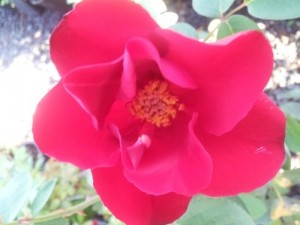 Introduced by Delbard-Chabert, France in 1966 Altissimo is still very popular today because it is an excellent climbing rose for walls, fences or to train as a pillar or support to the posts of a pergola. Altissimo is a vigorous climbing rose with stiff stems capable of branching readily if used to espalier on a wall or fence where it would flower more like a floribunda/cluster-flowered rose and to which it is particularly suited for masses of flowers – grown in this way, Altissimo will cover a wall 3mts x 3mts and be an absolute sight to behold throughout the entire flowering season.
Introduced by Delbard-Chabert, France in 1966 Altissimo is still very popular today because it is an excellent climbing rose for walls, fences or to train as a pillar or support to the posts of a pergola. Altissimo is a vigorous climbing rose with stiff stems capable of branching readily if used to espalier on a wall or fence where it would flower more like a floribunda/cluster-flowered rose and to which it is particularly suited for masses of flowers – grown in this way, Altissimo will cover a wall 3mts x 3mts and be an absolute sight to behold throughout the entire flowering season.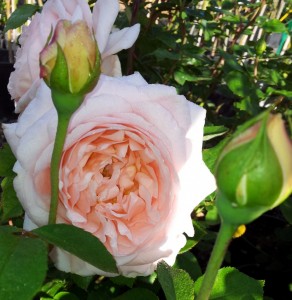 Bred by David Austin, 1990 and still a very popular rose today, more likely for the fact that it has a very rich myrrh fragrance which is overwhelming when this rose is planted as a group of no less than three plants.
Bred by David Austin, 1990 and still a very popular rose today, more likely for the fact that it has a very rich myrrh fragrance which is overwhelming when this rose is planted as a group of no less than three plants.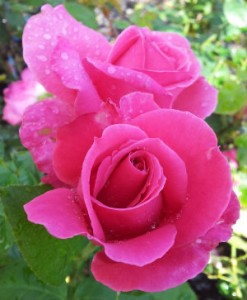 Bred by Meilland of France in 1998 and registered as ‘Caprice de Meilland’ until it came into Australia and was released under it’s current name: Best Friend. This magnificent rose was named by the R.S.P.C.A to honour the unconditional love and special friendship which all animal lovers cherish. This exquisite rose produces long, strong stems of the most highly fragrant bright pink roses which are ideally suited for flower arrangements. The attractive large leaves are rather light green and the only warning with this rose is that it should be placed in an open position with lots of airflow because it has a tendency to get powdery mildew if it is against a wall or has other plants growing below it!
Bred by Meilland of France in 1998 and registered as ‘Caprice de Meilland’ until it came into Australia and was released under it’s current name: Best Friend. This magnificent rose was named by the R.S.P.C.A to honour the unconditional love and special friendship which all animal lovers cherish. This exquisite rose produces long, strong stems of the most highly fragrant bright pink roses which are ideally suited for flower arrangements. The attractive large leaves are rather light green and the only warning with this rose is that it should be placed in an open position with lots of airflow because it has a tendency to get powdery mildew if it is against a wall or has other plants growing below it!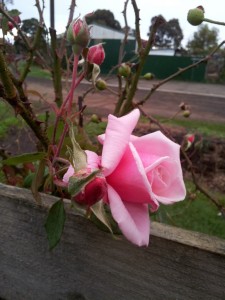 Bred by O’Neal, USA in 1951 this climbing rose is one of the most adaptable of all the climbers – it can be a pillar, it can be a rambling rose if you give it support to go on and on, it can be a shorter climber over an arch or it can be espaliered. Whichever way you wish to grow this wonderful rose, be sure to have the secateurs ready to cut the heavenly flowers for a vase!
Bred by O’Neal, USA in 1951 this climbing rose is one of the most adaptable of all the climbers – it can be a pillar, it can be a rambling rose if you give it support to go on and on, it can be a shorter climber over an arch or it can be espaliered. Whichever way you wish to grow this wonderful rose, be sure to have the secateurs ready to cut the heavenly flowers for a vase! Bred by Delbard & Chabert, 1990, this delightful rose begs you to pick the buds and place them in a vase where they will slowly proceed to open and display a delightful cluster of stamens.
Bred by Delbard & Chabert, 1990, this delightful rose begs you to pick the buds and place them in a vase where they will slowly proceed to open and display a delightful cluster of stamens. Bred by Delbard & Chabert, 1990, this delightful rose begs you to pick the buds and place them in a vase where they will slowly proceed to open and display a delightful cluster of stamens.
Bred by Delbard & Chabert, 1990, this delightful rose begs you to pick the buds and place them in a vase where they will slowly proceed to open and display a delightful cluster of stamens.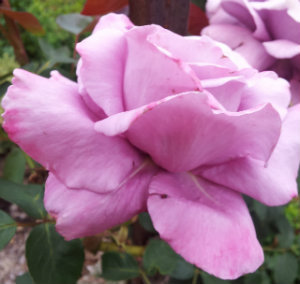 Another beautiful Hybrid Tea rose from the Meilland’s of France, this sensational rose has been available to rose gardeners in Australia since the mid 70’s. In New Zealand this rose is known as ‘Katherine Mansfield’ – one of their great writers. This rose was named after the renowned and great French Statesman “Charles de Gaulle”.
Another beautiful Hybrid Tea rose from the Meilland’s of France, this sensational rose has been available to rose gardeners in Australia since the mid 70’s. In New Zealand this rose is known as ‘Katherine Mansfield’ – one of their great writers. This rose was named after the renowned and great French Statesman “Charles de Gaulle”.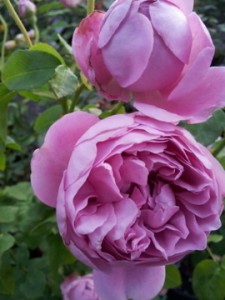 Bred by
Bred by 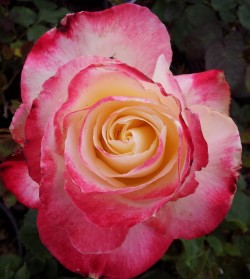 Bred in the USA by Swim & Ellis in 1976 this magnificent rose will be seen in gardens throughout Australia – popular mostly for the incredibly sweet perfume which is always evident and even a person with poor sense of smell will experience the pleasure of rose fragrance with this beauty. Double Delight has been a favourite rose with gardeners for many years and was inducted to the World Federation of Rose Societies, Rose Hall of Fame in 1985 being voted the people’s choice most popular rose in that year. It’s popularity is probably the cause of it’s demise as today, the bush is more difficult to grow because it has a lot of disease issues!
Bred in the USA by Swim & Ellis in 1976 this magnificent rose will be seen in gardens throughout Australia – popular mostly for the incredibly sweet perfume which is always evident and even a person with poor sense of smell will experience the pleasure of rose fragrance with this beauty. Double Delight has been a favourite rose with gardeners for many years and was inducted to the World Federation of Rose Societies, Rose Hall of Fame in 1985 being voted the people’s choice most popular rose in that year. It’s popularity is probably the cause of it’s demise as today, the bush is more difficult to grow because it has a lot of disease issues! Bred by Tom Carruth, USA, 2004 this wonderful rose created a massive impact for the intense colour and fragrance which was rarely seen in modern roses. This very free-flowering rose bears flowers in small clusters with an amazingly intense clove fragrance throughout the flowering season.
Bred by Tom Carruth, USA, 2004 this wonderful rose created a massive impact for the intense colour and fragrance which was rarely seen in modern roses. This very free-flowering rose bears flowers in small clusters with an amazingly intense clove fragrance throughout the flowering season.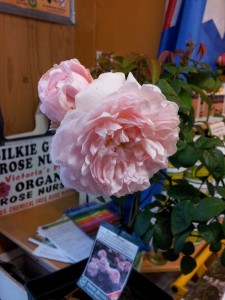 Introduced by
Introduced by 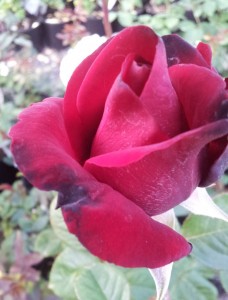 Bred by Kordes, Germany, released in Australia in the late 90’s, this rose continues to be popular to home gardeners because of the intense black-red coupled with an amazingly rich rose fragrance.
Bred by Kordes, Germany, released in Australia in the late 90’s, this rose continues to be popular to home gardeners because of the intense black-red coupled with an amazingly rich rose fragrance.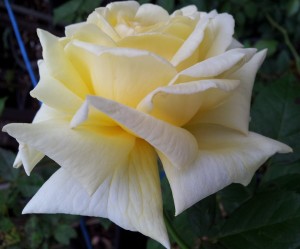 Bred by Dickson, UK, 1984, Elina commands recognition wherever she is planted by the robust height alone! Elina is a strong, vigorous bush with dark-green very disease-resistant foliage which adds enormous beauty as a foil for the huge, magnificently formed ivory blooms which are at least 15cms across and make perfect exhibition specimens, lasting very well in the vase. There is little fragrance.
Bred by Dickson, UK, 1984, Elina commands recognition wherever she is planted by the robust height alone! Elina is a strong, vigorous bush with dark-green very disease-resistant foliage which adds enormous beauty as a foil for the huge, magnificently formed ivory blooms which are at least 15cms across and make perfect exhibition specimens, lasting very well in the vase. There is little fragrance. Raised in USA, this rose is a symbol of pure love so whether you’re falling in love for the first time or you’re experiencing it again, this rose will certainly make your heart go pitter-patter with its soft creamy pink inner petals and porcelain white reverse.
Raised in USA, this rose is a symbol of pure love so whether you’re falling in love for the first time or you’re experiencing it again, this rose will certainly make your heart go pitter-patter with its soft creamy pink inner petals and porcelain white reverse. Bred by Meilland, France has rich, dark velvety red blooms in a classical Hybrid Tea bud and then the bloom reveals a massive swirl of petals deep in the bud as it opens.
Bred by Meilland, France has rich, dark velvety red blooms in a classical Hybrid Tea bud and then the bloom reveals a massive swirl of petals deep in the bud as it opens.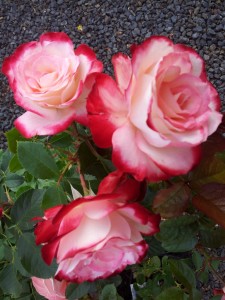 Fire ‘n’ Ice should be widely grown for it’s immense disease resistance. The foliage is lush and glossy dark green and makes a wonderful foil for the magnificent procession of strong stems of blooms all over the shrub.
Fire ‘n’ Ice should be widely grown for it’s immense disease resistance. The foliage is lush and glossy dark green and makes a wonderful foil for the magnificent procession of strong stems of blooms all over the shrub. Bred by Joseph Orard prior to 1998 and introduced to Australia in 2009 this glorious specimen with tall single stems of the most highly fragrant dark red rose which is suitable to work with in floral art and yet easy to grow in the open garden will be a joy to all rose gardeners. The men will rush out to buy it because it has so very few thorns and tell us in the nursery that they just love the red roses … we know it’s all about the lack of thorns even though we also know that men prefer their garden roses to be red!
Bred by Joseph Orard prior to 1998 and introduced to Australia in 2009 this glorious specimen with tall single stems of the most highly fragrant dark red rose which is suitable to work with in floral art and yet easy to grow in the open garden will be a joy to all rose gardeners. The men will rush out to buy it because it has so very few thorns and tell us in the nursery that they just love the red roses … we know it’s all about the lack of thorns even though we also know that men prefer their garden roses to be red!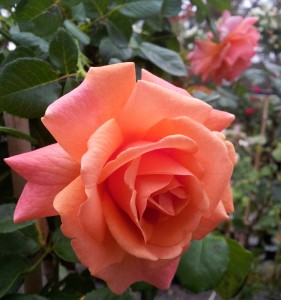 Bred by Harkness, UK, this extraordinarily disease-resistant floribunda rose was awarded “Best Rose” in the Australian National Rose Trial Gardens in Adelaide in 2011 and will be seen in the coming years growing in road-side and park plantings throughout Australia because it is so readily adaptable to all climates and growing conditions – this is a very tough, free-flowering rose!
Bred by Harkness, UK, this extraordinarily disease-resistant floribunda rose was awarded “Best Rose” in the Australian National Rose Trial Gardens in Adelaide in 2011 and will be seen in the coming years growing in road-side and park plantings throughout Australia because it is so readily adaptable to all climates and growing conditions – this is a very tough, free-flowering rose!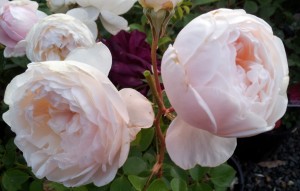 Raised by David Austin, UK, 1992 by a crossing of two magnificent roses in the English Roses series: Graham Thomas x Mary Rose and this beautiful rose possesses great qualities from both parents – the lovely cupped shape from the father Graham and massive petal formation and fragrance from the mother, Mary. One might ask, how do you get a nearly pure white rose from yellow and pink parents? … Oh, the mystery of the roses!
Raised by David Austin, UK, 1992 by a crossing of two magnificent roses in the English Roses series: Graham Thomas x Mary Rose and this beautiful rose possesses great qualities from both parents – the lovely cupped shape from the father Graham and massive petal formation and fragrance from the mother, Mary. One might ask, how do you get a nearly pure white rose from yellow and pink parents? … Oh, the mystery of the roses!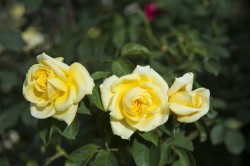 Bred by Paolino, France, 1978 with the climbing version also introduced by Meilland in 1991 this magnificent rose is one of the significant heralds that Spring is sprung and once Gold Bunny starts flowering, it literally does not stop. There is an abundance of large, fluffy and warm golden yellow blooms which fade to cream on a short bush with lush mid-green, healthy foliage.
Bred by Paolino, France, 1978 with the climbing version also introduced by Meilland in 1991 this magnificent rose is one of the significant heralds that Spring is sprung and once Gold Bunny starts flowering, it literally does not stop. There is an abundance of large, fluffy and warm golden yellow blooms which fade to cream on a short bush with lush mid-green, healthy foliage. Bred by David Austin, 1992 this magnificent rose has two sensational parents and they are both climbing roses here is Australia’s warm climate – Charles Austin and Abraham Darby.
Bred by David Austin, 1992 this magnificent rose has two sensational parents and they are both climbing roses here is Australia’s warm climate – Charles Austin and Abraham Darby.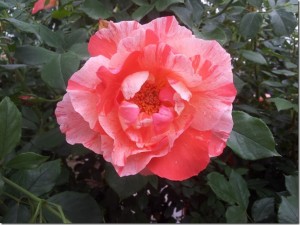 Introduced by Delbard in 1997 and sharing the name of Prince Rainier of Monaco, Grimaldi leaves a lasting impression of the exceptionally elegant beauty of Princess Grace of Monaco – delicate but strong. This robust and highly disease-resistant shrub rose which flowers from season start to season end and all the way in between, is a magnificent sight when planted in groups so that the flowering bracts can be supported and pushed upwards by each other.
Introduced by Delbard in 1997 and sharing the name of Prince Rainier of Monaco, Grimaldi leaves a lasting impression of the exceptionally elegant beauty of Princess Grace of Monaco – delicate but strong. This robust and highly disease-resistant shrub rose which flowers from season start to season end and all the way in between, is a magnificent sight when planted in groups so that the flowering bracts can be supported and pushed upwards by each other. Bred by Mallerin, France, 1938 this rose is a spectacle to behold when it is one of the very first roses to herald the arrival of Spring – being a climbing rose makes it’s arrival so much more spectacular because it is often hard to see any foliage because the flowering is so intense.
Bred by Mallerin, France, 1938 this rose is a spectacle to behold when it is one of the very first roses to herald the arrival of Spring – being a climbing rose makes it’s arrival so much more spectacular because it is often hard to see any foliage because the flowering is so intense. A sport of ‘Kardinal’ discovered by Graeme Catt and released in 2000 this lovely rose is the most appropriate gift on the occasion of a wedding anniversary and will continue to remind the recipient of their special day by producing the most amazing number of blooms that are neither red nor orange but a blend of both with some apricot thrown in just to give a subtle loveliness to what might otherwise be a harsh colour.
A sport of ‘Kardinal’ discovered by Graeme Catt and released in 2000 this lovely rose is the most appropriate gift on the occasion of a wedding anniversary and will continue to remind the recipient of their special day by producing the most amazing number of blooms that are neither red nor orange but a blend of both with some apricot thrown in just to give a subtle loveliness to what might otherwise be a harsh colour. Bred by Georges Delbard, France and released in 1996, this relatively new rose in Australia has enjoyed the publicity of the Delbard roses and this beauty is particularly favoured because it does so well as a cut flower specimen.
Bred by Georges Delbard, France and released in 1996, this relatively new rose in Australia has enjoyed the publicity of the Delbard roses and this beauty is particularly favoured because it does so well as a cut flower specimen.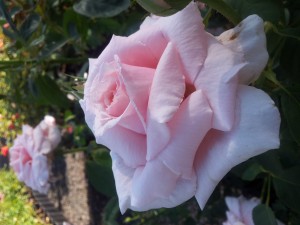 Bred by Harkness, UK, 1994 this lovely climbing rose is a welcome addition to the group of climbing roses now available in Australia.
Bred by Harkness, UK, 1994 this lovely climbing rose is a welcome addition to the group of climbing roses now available in Australia.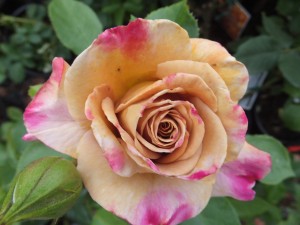 Introduced by Weeks Roses in 2005 (bred by James Sproul), Honey Dijon is outstandingly healthy and disease-resistant which makes it possible for the home-gardener to grow this novelty-coloured rose when most earlier roses with ‘brown’ tones were difficult to grow.
Introduced by Weeks Roses in 2005 (bred by James Sproul), Honey Dijon is outstandingly healthy and disease-resistant which makes it possible for the home-gardener to grow this novelty-coloured rose when most earlier roses with ‘brown’ tones were difficult to grow.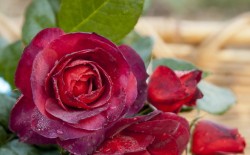 Bred by Tom Carruth, USA, 2001 this extraordinary rose should never be planted at the back of the rose garden because you will be drawn to the most unusual array of colours every time you visit with it … early in the season, the buds can be quite orange on the outer petals however, the surprise is when the bud opens, the petals are distinctly brown and then as they age, they turn are dusky, muddy mauve .. so very pretty at all stages and when the bush is in full bloom, the colour range is amazing!
Bred by Tom Carruth, USA, 2001 this extraordinary rose should never be planted at the back of the rose garden because you will be drawn to the most unusual array of colours every time you visit with it … early in the season, the buds can be quite orange on the outer petals however, the surprise is when the bud opens, the petals are distinctly brown and then as they age, they turn are dusky, muddy mauve .. so very pretty at all stages and when the bush is in full bloom, the colour range is amazing! Bred by Kordes in 1958 and worthy of the title we use for it: “Rose of the Century” because of it’s extremely healthy and free-flowering, easy care qualities. Inducted to the Rose Hall of Fame in 1983.
Bred by Kordes in 1958 and worthy of the title we use for it: “Rose of the Century” because of it’s extremely healthy and free-flowering, easy care qualities. Inducted to the Rose Hall of Fame in 1983.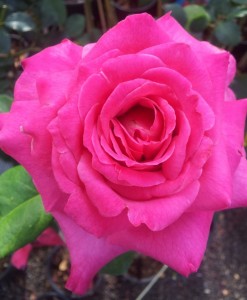 Bred by Nieuwesteeg, Victoria, Australia, released in 2004 and then proceeding to be awarded a Certificate of Merit for the Best Hybrid Tea at the National Rose Trial Gardens of Australia.
Bred by Nieuwesteeg, Victoria, Australia, released in 2004 and then proceeding to be awarded a Certificate of Merit for the Best Hybrid Tea at the National Rose Trial Gardens of Australia.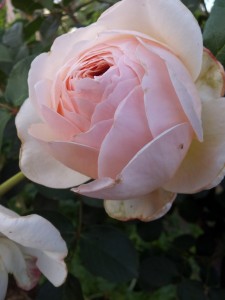 Bred by David Austin, UK, 1995 this is now one of the most popular of the English Roses because of the beautifully and deeply cupped flowers which present an imposing sight and then totally enthral you when you take the cup and breathe the glorious fruity fragrance.
Bred by David Austin, UK, 1995 this is now one of the most popular of the English Roses because of the beautifully and deeply cupped flowers which present an imposing sight and then totally enthral you when you take the cup and breathe the glorious fruity fragrance.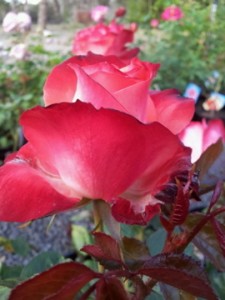 Bred by Tantau, Germany, this beautiful rose was released in Australia in 1996 to raise funds for the Rotary Health Research Foundation.
Bred by Tantau, Germany, this beautiful rose was released in Australia in 1996 to raise funds for the Rotary Health Research Foundation.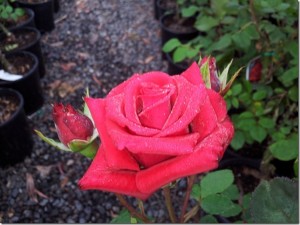 Raised by Kordes, Germany 1985 and originally produced for the cut-flower market, this rose does exceedingly well in the home garden and one bush will continually produce many perfect flowers. However, if three bushes are planted in a clump, gardeners would never have to purchase a red rose from the florist because this abundant flowering rose will generously provide bunches of vase quality roses throughout the season.
Raised by Kordes, Germany 1985 and originally produced for the cut-flower market, this rose does exceedingly well in the home garden and one bush will continually produce many perfect flowers. However, if three bushes are planted in a clump, gardeners would never have to purchase a red rose from the florist because this abundant flowering rose will generously provide bunches of vase quality roses throughout the season.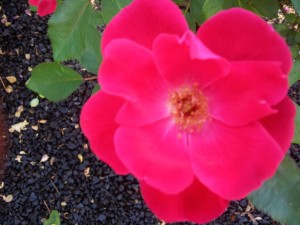 Bred by William J. Radler, USA, 1999, Knock Out has received prestigious awards in trial gardens throughout the world and in 2005 became the most purchased landscape rose in the United States and in 2010, the best selling rose of all time!
Bred by William J. Radler, USA, 1999, Knock Out has received prestigious awards in trial gardens throughout the world and in 2005 became the most purchased landscape rose in the United States and in 2010, the best selling rose of all time! Introduced by Meilland, France in 1982 creating a break-though into the ‘Landscape’ series of roses when it was first released in Australia.
Introduced by Meilland, France in 1982 creating a break-though into the ‘Landscape’ series of roses when it was first released in Australia.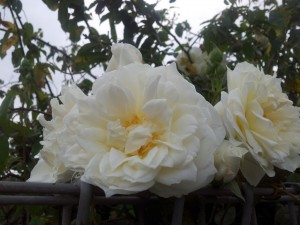 Bred by Marechal, France, 1830, this magnificent Noisette rose has stood the test of time and is still widely grown today.
Bred by Marechal, France, 1830, this magnificent Noisette rose has stood the test of time and is still widely grown today. Bred by
Bred by 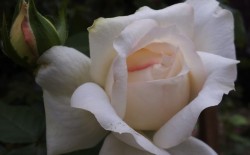 Bred by Alain Meilland, Antibes, France, in 2001 this magnificent rose has all the style and flair, the resilience and beauty we love about Maggie Tabberer!
Bred by Alain Meilland, Antibes, France, in 2001 this magnificent rose has all the style and flair, the resilience and beauty we love about Maggie Tabberer! Bred by Meilland, France, this rose is an ideal birthday gift for the person who has everything and might be difficult to find something lovely for to remember their day!
Bred by Meilland, France, this rose is an ideal birthday gift for the person who has everything and might be difficult to find something lovely for to remember their day!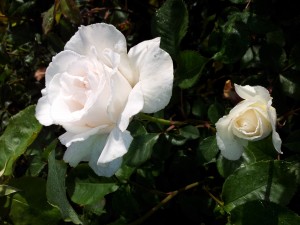 Raised by Harkness, UK, 1977 this glorious rose makes an outstanding addition to the rose garden producing the most perfectly formed, purest white blooms which, when opened, reveal a bed of dark crimson stamens which attract the bees!
Raised by Harkness, UK, 1977 this glorious rose makes an outstanding addition to the rose garden producing the most perfectly formed, purest white blooms which, when opened, reveal a bed of dark crimson stamens which attract the bees! Bred by Guillot-Massad, France, 1996 this delightfully recurrent blooming shrub is tall and supports the blooms well on branching canes. This commanding rose produces masses of heavily-petalled creamy blooms sometimes flushed pink at the edges – mostly in the cooler weather.
Bred by Guillot-Massad, France, 1996 this delightfully recurrent blooming shrub is tall and supports the blooms well on branching canes. This commanding rose produces masses of heavily-petalled creamy blooms sometimes flushed pink at the edges – mostly in the cooler weather.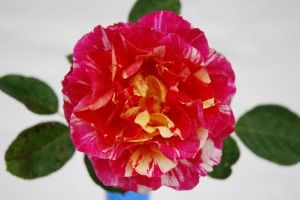 Introduced by Delbard in 2003 it is this rose that I can lay the blame for my passion and love of the striped roses. I previously deplored the striped roses but had planted two standards of Maurice in the nature-strip garden bed which I had to walk past every morning. The extreme difference in each bloom attracted my attention and more and more I came to enjoy the beauty in the craziness!
Introduced by Delbard in 2003 it is this rose that I can lay the blame for my passion and love of the striped roses. I previously deplored the striped roses but had planted two standards of Maurice in the nature-strip garden bed which I had to walk past every morning. The extreme difference in each bloom attracted my attention and more and more I came to enjoy the beauty in the craziness!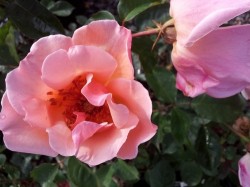 Bred by Gosset, UK, 1954 this very adaptable climbing rose demands attention with her large open blooms which display a bed of crimson stamens.
Bred by Gosset, UK, 1954 this very adaptable climbing rose demands attention with her large open blooms which display a bed of crimson stamens.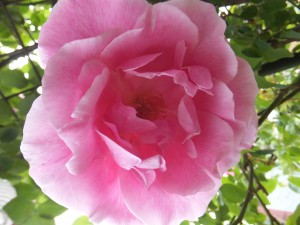 Bred by Pedro Dot, Spain, this magnificent rose is sometimes listed as “Spanish Beauty” which this rose most certainly is – the swirling waved petals of mid pink with slightly crimson flush on the reverse remind one of a Spanish dancer waving her frivolous skirts!
Bred by Pedro Dot, Spain, this magnificent rose is sometimes listed as “Spanish Beauty” which this rose most certainly is – the swirling waved petals of mid pink with slightly crimson flush on the reverse remind one of a Spanish dancer waving her frivolous skirts! Bred by David Austin and introduced in 1994 this is one of the most neatly compact of the English Roses. The bush is lovely and rounded and of medium height to around 1 metre tall and almost as wide making this rose ideal for the rose garden border.
Bred by David Austin and introduced in 1994 this is one of the most neatly compact of the English Roses. The bush is lovely and rounded and of medium height to around 1 metre tall and almost as wide making this rose ideal for the rose garden border.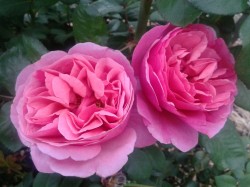 Bred by Bernaix, France, 1891, is synonymous with the rose named ‘Archiduc Joseph’ and it is a very widely grown old Tea Rose which you might find in an old cemetery or the only surviving rose at the deserted farm-house. If left to its own devices, this magnificent rose can grow to immense size but is also very comfortable with pruning.
Bred by Bernaix, France, 1891, is synonymous with the rose named ‘Archiduc Joseph’ and it is a very widely grown old Tea Rose which you might find in an old cemetery or the only surviving rose at the deserted farm-house. If left to its own devices, this magnificent rose can grow to immense size but is also very comfortable with pruning. Raised by
Raised by  Released by Swane’s Nursery this magnificent rose will please you as a specimen rose in the rose garden and delight you when you receive the award for ‘Best Rose in the Show’ at your local rose show. Each bloom is a dedication to perfection of rose flowers.
Released by Swane’s Nursery this magnificent rose will please you as a specimen rose in the rose garden and delight you when you receive the award for ‘Best Rose in the Show’ at your local rose show. Each bloom is a dedication to perfection of rose flowers. Bred by Dee Bennett, USA, 1989 this wonderful rose graces many gardens as a remembrance rose and because of its extremely hardy nature and reliable repeat flowering, I never hesitate to recommend this rose as a gift to the least green-thumbed gardener – once in the ground this rose will perform and be a delightful reminder of the Mother for whom it was planted.
Bred by Dee Bennett, USA, 1989 this wonderful rose graces many gardens as a remembrance rose and because of its extremely hardy nature and reliable repeat flowering, I never hesitate to recommend this rose as a gift to the least green-thumbed gardener – once in the ground this rose will perform and be a delightful reminder of the Mother for whom it was planted.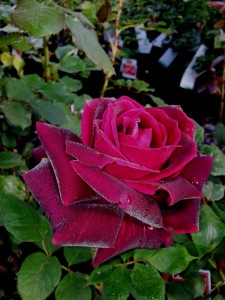 Bred by Swim & Weeks, USA, 1964 this very tall growing rose to 1.8 metres should be planted at the back of the rose bed where it will shine over and above all the roses and the breath-taking fragrance will still be enjoyed.
Bred by Swim & Weeks, USA, 1964 this very tall growing rose to 1.8 metres should be planted at the back of the rose bed where it will shine over and above all the roses and the breath-taking fragrance will still be enjoyed.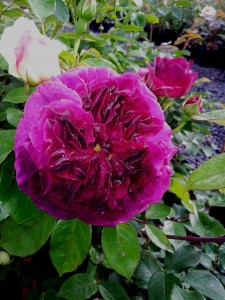 Bred by David Austin, UK, and released in 2010 in Australia this rose has all the qualities we now expect in the recently released English Roses – great hybrid vigour and superb disease resistance.
Bred by David Austin, UK, and released in 2010 in Australia this rose has all the qualities we now expect in the recently released English Roses – great hybrid vigour and superb disease resistance.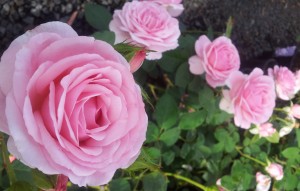 Released by Swane’s Nursery this rose is exclusively grown in Australia and our conditions are perfectly suited to this exceptionally healthy, free flowering rose.
Released by Swane’s Nursery this rose is exclusively grown in Australia and our conditions are perfectly suited to this exceptionally healthy, free flowering rose.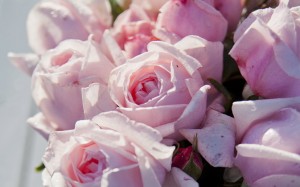 Raised by Georges Delbard, France, 2006 with a renowned perfume in the Guerlain range based on the essence of this wonderful rose.
Raised by Georges Delbard, France, 2006 with a renowned perfume in the Guerlain range based on the essence of this wonderful rose.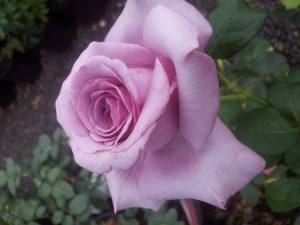 Raised in the USA and released by Swane’s Nursery, this sensational rose will surely play a competition with the old, very widely grown ‘Blue Moon’ rose and most likely come out the winner because the flowers are very sturdy and long lasting on the bush or in a vase.
Raised in the USA and released by Swane’s Nursery, this sensational rose will surely play a competition with the old, very widely grown ‘Blue Moon’ rose and most likely come out the winner because the flowers are very sturdy and long lasting on the bush or in a vase.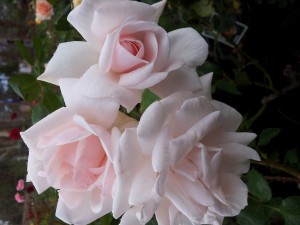 Sport of Dr. W. van Fleet, introduced in 1930 by Somerset Rose Nursery and inducted to the World Rose Hall of Fame in 1997 this wonderful climbing rose is seen in some of the oldest gardens in Australia and because of it’s R. wichuriana parentage, the pliable though thorny canes, make it a climber suitable to accommodate any garden design … you be the boss and New Dawn will comfortably comply with whatever you wish it to do. Let it have it’s head and scramble over an old garden shed, attach it to the fence and cut it frequently, attach it to a pillar in the middle of a garden bed and then let it go to the sky or train it over a garden arch and attack it once a year with the hedger.
Sport of Dr. W. van Fleet, introduced in 1930 by Somerset Rose Nursery and inducted to the World Rose Hall of Fame in 1997 this wonderful climbing rose is seen in some of the oldest gardens in Australia and because of it’s R. wichuriana parentage, the pliable though thorny canes, make it a climber suitable to accommodate any garden design … you be the boss and New Dawn will comfortably comply with whatever you wish it to do. Let it have it’s head and scramble over an old garden shed, attach it to the fence and cut it frequently, attach it to a pillar in the middle of a garden bed and then let it go to the sky or train it over a garden arch and attack it once a year with the hedger.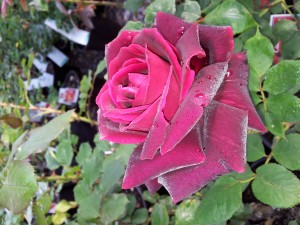 Bred in the USA by Swim & Weeks in 1964 it was named after the State of Oklahoma which translates to: ‘Red Man’s Land’ – how appropriate because men really do love this rose.
Bred in the USA by Swim & Weeks in 1964 it was named after the State of Oklahoma which translates to: ‘Red Man’s Land’ – how appropriate because men really do love this rose. Bred in the USA, this wonderful rose passed rigorous testing in the Australian Rose Trial Gardens in Adelaide, came out with a Bronze Medal in 2009 and is now enjoying a place in hot Australian gardens where it flourishes!
Bred in the USA, this wonderful rose passed rigorous testing in the Australian Rose Trial Gardens in Adelaide, came out with a Bronze Medal in 2009 and is now enjoying a place in hot Australian gardens where it flourishes! Bred by David Austin, UK, 1987 I am usually able to identify this rose because it is dark crimson red which ages to purple. As it becomes purple, there is a noticeable hint of orange through the purple and it has huge blooms with masses of ruffled petals. The plethora of thorns are also a good identifier.
Bred by David Austin, UK, 1987 I am usually able to identify this rose because it is dark crimson red which ages to purple. As it becomes purple, there is a noticeable hint of orange through the purple and it has huge blooms with masses of ruffled petals. The plethora of thorns are also a good identifier. Raised by Delbard, France and released in 1995 when George Delbard turned 90 years of age this grand, vigorous climber produces masses of large flat blooms with an immense number of petals. The flower colour varies throughout the season with deep pink centre petals leading out to warm apricot and fading to creamy yellow.
Raised by Delbard, France and released in 1995 when George Delbard turned 90 years of age this grand, vigorous climber produces masses of large flat blooms with an immense number of petals. The flower colour varies throughout the season with deep pink centre petals leading out to warm apricot and fading to creamy yellow. Bred by Weeks, USA, 1978 and synonymous with the name ‘Burning Sky’ the lovely old Hybrid Tea is renowned as being one of the most free-flowering bush roses as from one bush, you can trim a whole bucket full of long-stemmed, perfect flowers and still leave some on the bush.
Bred by Weeks, USA, 1978 and synonymous with the name ‘Burning Sky’ the lovely old Hybrid Tea is renowned as being one of the most free-flowering bush roses as from one bush, you can trim a whole bucket full of long-stemmed, perfect flowers and still leave some on the bush.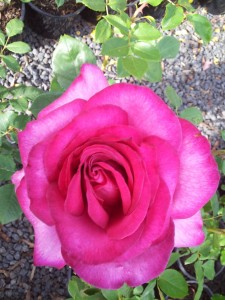 Bred by Kordes, Germany and released in Australia in 2002, this is one of the largest blooms produced on any hybrid tea rose – once measured 22cms across – with huge petals of the darkest, hottest pink with a light slash of silver on some of the petals.
Bred by Kordes, Germany and released in Australia in 2002, this is one of the largest blooms produced on any hybrid tea rose – once measured 22cms across – with huge petals of the darkest, hottest pink with a light slash of silver on some of the petals. Raised by David Austin, UK in 1995 and named for his wife this extraordinarily healthy and free flowering rose is a wonderfully bright addition to the
Raised by David Austin, UK in 1995 and named for his wife this extraordinarily healthy and free flowering rose is a wonderfully bright addition to the  Raised by Harkness, UK this multiple Award Winning rose produces striking and luminous bright red perfectly formed blooms over a very long season and has a slight perfume – ideal in a vase.
Raised by Harkness, UK this multiple Award Winning rose produces striking and luminous bright red perfectly formed blooms over a very long season and has a slight perfume – ideal in a vase. Bred by Cocker of Scotland in 1976 this incredibly delightful rose should be more widely planted for it’s generous ability to produce immense clusters of flowers throughout the flowering season without any care or concern for the weather or however you maintain or neglect it – it’s such a happy rose which was originally named ‘Cheerio’!
Bred by Cocker of Scotland in 1976 this incredibly delightful rose should be more widely planted for it’s generous ability to produce immense clusters of flowers throughout the flowering season without any care or concern for the weather or however you maintain or neglect it – it’s such a happy rose which was originally named ‘Cheerio’! Bred by David Austin, UK, 1983 this beautiful little shrub should always be planted in a group of three to truly enjoy the bright warm pink, rosette shaped flowers.
Bred by David Austin, UK, 1983 this beautiful little shrub should always be planted in a group of three to truly enjoy the bright warm pink, rosette shaped flowers. Bred by David Austin, UK, released in Australia in 2010 to complement the already large range of English Roses we enjoy in the Australian landscape. This rose is one of the most disease resistant!
Bred by David Austin, UK, released in Australia in 2010 to complement the already large range of English Roses we enjoy in the Australian landscape. This rose is one of the most disease resistant!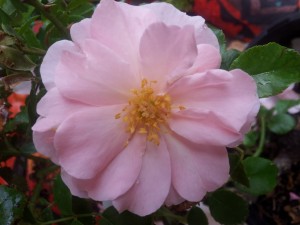 Bred by Kordes, Germany in 1991 this immensely pretty rose would be an ideal rose to plant around the border of a garden bed where it will spill over the edge creating a shrub about 75 tall x 1.25 cms wide and could be treated as a hedge – cut with clippers or mechanical hedger immediately after flowering and it would continue to flower throughout the season with an abundance of loosely formed pale pink blooms which will fade during times when the sun is very hot.
Bred by Kordes, Germany in 1991 this immensely pretty rose would be an ideal rose to plant around the border of a garden bed where it will spill over the edge creating a shrub about 75 tall x 1.25 cms wide and could be treated as a hedge – cut with clippers or mechanical hedger immediately after flowering and it would continue to flower throughout the season with an abundance of loosely formed pale pink blooms which will fade during times when the sun is very hot. Raised by Cocker & Sons of Scotland in 1984 this wonderful rose flowers in many gardens around Australia for this reason:
Raised by Cocker & Sons of Scotland in 1984 this wonderful rose flowers in many gardens around Australia for this reason: Although thought to be a Species rose from China before 1894 this spectacular rose is probably an old Chinese garden hybrid with characteristically mysterious origins. This rose is very highly recommend for use as a thick impenetrable rose hedge which would attain a height to at least 2 metres and spread of no less than 1.5 metres.
Although thought to be a Species rose from China before 1894 this spectacular rose is probably an old Chinese garden hybrid with characteristically mysterious origins. This rose is very highly recommend for use as a thick impenetrable rose hedge which would attain a height to at least 2 metres and spread of no less than 1.5 metres.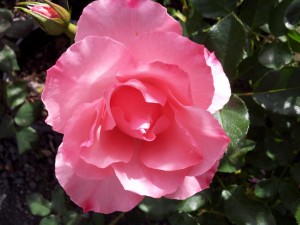 Raised by Kordes, Germany, 1988 and one of the earliest of the modern shrub roses which is suited to almost any sunny situation in the rose garden. Use it as a hedge, a border, in tubs, or as a free-standing specimen amongst the other roses this rose will flower continually, producing the most delicate-looking mid pink flowers which are in no way delicate since they last an extraordinarily long time on the bush and are a dream to work with as a cut flower.
Raised by Kordes, Germany, 1988 and one of the earliest of the modern shrub roses which is suited to almost any sunny situation in the rose garden. Use it as a hedge, a border, in tubs, or as a free-standing specimen amongst the other roses this rose will flower continually, producing the most delicate-looking mid pink flowers which are in no way delicate since they last an extraordinarily long time on the bush and are a dream to work with as a cut flower. Bred by Cochet-Cochet, France, 1901 produces masses of large double flowers of crimson-red to rosy magenta in a cluster or muddled petals.
Bred by Cochet-Cochet, France, 1901 produces masses of large double flowers of crimson-red to rosy magenta in a cluster or muddled petals. Bred by Poulson, Denmark, 1973 the beautiful, uniquely coloured blooms are very high centred large flowers, borne mostly on single stems and carrying an intense fruity fragrance.
Bred by Poulson, Denmark, 1973 the beautiful, uniquely coloured blooms are very high centred large flowers, borne mostly on single stems and carrying an intense fruity fragrance.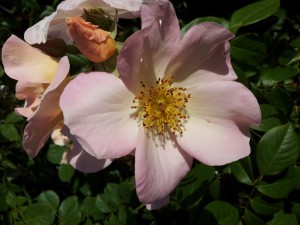 Raised by amateur rose breeder, Holmes, UK, 1976 this extremely popular modern shrub rose produces the most magnificent bracts of 5-petalled creamy-white blooms with a blush at the edge of each petal in the extremely cold weather and a splash of golden yellow stamens.
Raised by amateur rose breeder, Holmes, UK, 1976 this extremely popular modern shrub rose produces the most magnificent bracts of 5-petalled creamy-white blooms with a blush at the edge of each petal in the extremely cold weather and a splash of golden yellow stamens.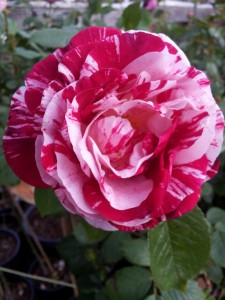 Raised by Tom Carruth, USA, 1999 produces masses of medium sized pointed buds mostly in clusters, and opening with a riot of stripes of burgundy-red and creamy white where no two flowers are exactly the same.
Raised by Tom Carruth, USA, 1999 produces masses of medium sized pointed buds mostly in clusters, and opening with a riot of stripes of burgundy-red and creamy white where no two flowers are exactly the same.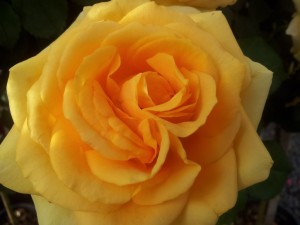 Raised by Tantau, Germany, this extremely disease-resistant rose has many qualities which make it ideal for planting in a variety of rose garden situations and especially ideal as a potted specimen.
Raised by Tantau, Germany, this extremely disease-resistant rose has many qualities which make it ideal for planting in a variety of rose garden situations and especially ideal as a potted specimen.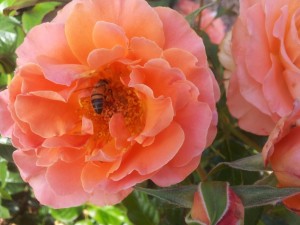 This rose was released in Australia by Landsdale Rose Gardens and part of the proceeds from the sale of this rose will go towards the development of the Slim Dusty Centre in Kempsey, NSW, Slim’s home town.
This rose was released in Australia by Landsdale Rose Gardens and part of the proceeds from the sale of this rose will go towards the development of the Slim Dusty Centre in Kempsey, NSW, Slim’s home town. Raised by Meilland, France and introduced to commemorate the 50th Anniversary of the naming of the original Peace rose to inspire us to never lose the spirit in striving for genuine, lasting peace!
Raised by Meilland, France and introduced to commemorate the 50th Anniversary of the naming of the original Peace rose to inspire us to never lose the spirit in striving for genuine, lasting peace! Bred by an amateur breeder, Frank Strickland, California, USA, 1995 by ‘Brandy’ x Gold Medal’ this stunning rose is a must-have if you like to exhibit at rose shows.
Bred by an amateur breeder, Frank Strickland, California, USA, 1995 by ‘Brandy’ x Gold Medal’ this stunning rose is a must-have if you like to exhibit at rose shows.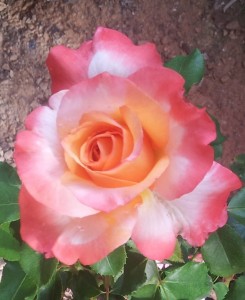 Released by Swane’s Nursery in 2011 this magnificent rose will delight the rose gardener who loves to pick roses for the vase and most especially, the gardener who enjoys bi-coloured roses.
Released by Swane’s Nursery in 2011 this magnificent rose will delight the rose gardener who loves to pick roses for the vase and most especially, the gardener who enjoys bi-coloured roses.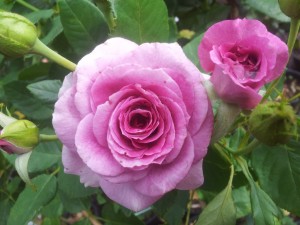 Raised in the USA and released by Swane’s Nursery this exceedingly showy rose is “The Ultimate Garden Vixen” producing massive heads of blooms which have rich magenta petals deep in the centre fading to sparkling amethyst outside petals.
Raised in the USA and released by Swane’s Nursery this exceedingly showy rose is “The Ultimate Garden Vixen” producing massive heads of blooms which have rich magenta petals deep in the centre fading to sparkling amethyst outside petals. Raised by Alain Meilland, France, 2004 this extremely free-flowering golden amber rose creates a festival of colour which tones perfectly with all other roses.
Raised by Alain Meilland, France, 2004 this extremely free-flowering golden amber rose creates a festival of colour which tones perfectly with all other roses.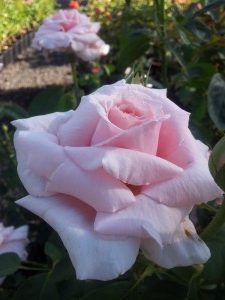 Raised by Meilland, France this highly fragrant rose has every single quality that one might expect from a rose which carries this lovely name!
Raised by Meilland, France this highly fragrant rose has every single quality that one might expect from a rose which carries this lovely name!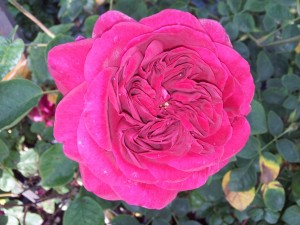 Bred by David Austin, UK, and one of the earliest crosses in 1991 of ‘Mary Rose’ x ‘Prospero’ it has qualities from both parents. The plant is upright, bushy and free flowering with medium sized, dark green foliage and lots of prickles.
Bred by David Austin, UK, and one of the earliest crosses in 1991 of ‘Mary Rose’ x ‘Prospero’ it has qualities from both parents. The plant is upright, bushy and free flowering with medium sized, dark green foliage and lots of prickles. Raised in the USA and released in Australia by Swane’s Nursery, this gutsy floribunda was awarded the Best Performer in the Fields of 2006. During the hot, dry summers of the drought, this rose just kept right on blooming.
Raised in the USA and released in Australia by Swane’s Nursery, this gutsy floribunda was awarded the Best Performer in the Fields of 2006. During the hot, dry summers of the drought, this rose just kept right on blooming. Bred by Kordes, Germany in 1989 Valencia has a colour of its very own – a blend of copper-yellow-cream and huge flowers, most especially in the warmer weather when it our-performs other roses for flower production and health.
Bred by Kordes, Germany in 1989 Valencia has a colour of its very own – a blend of copper-yellow-cream and huge flowers, most especially in the warmer weather when it our-performs other roses for flower production and health.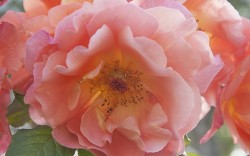 Bred by Kordes, Germany in 1969 this moderate climbing rose is suitable to position against a fence, espalier on a wall, grow as a pillar with support or allow to free-stand in a corner of the garden and billow.
Bred by Kordes, Germany in 1969 this moderate climbing rose is suitable to position against a fence, espalier on a wall, grow as a pillar with support or allow to free-stand in a corner of the garden and billow. Bred by Bizot, France in 1868 this lovely rose is very renowned for the fact that it is one of the very few climbing roses which is totally thornless and flowers profusely throughout the season.
Bred by Bizot, France in 1868 this lovely rose is very renowned for the fact that it is one of the very few climbing roses which is totally thornless and flowers profusely throughout the season.